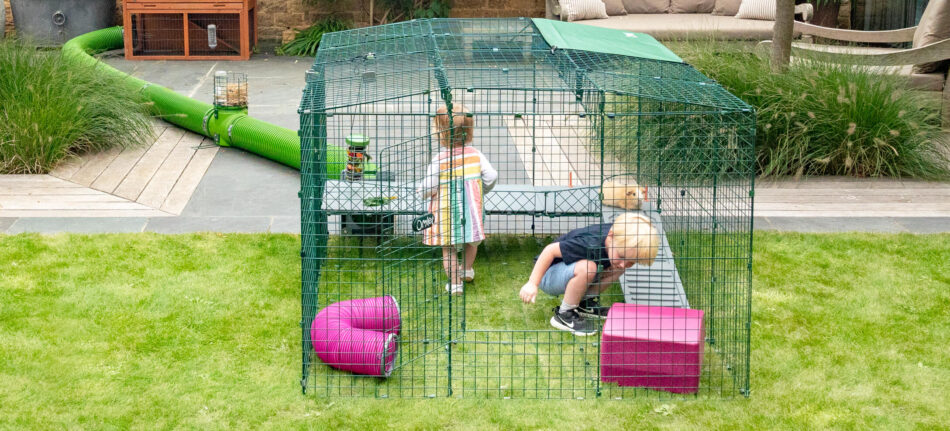
Welcome to guinea pig parenthood! Whilst your new furr baby will be relatively low-maintenance, as with any type of pet ownership, it’s your responsibility to keep your cavy safe and to ensure they live a happy and fulfilled life. But what exactly do you need to do to make sure that your guinea pig is a grinny pig, and is there anything you definitely should not do?
Guinea pigs bedding dos and don’ts
Do use a guinea pig bedding with good absorbency. This will reduce odors, and create a more hygienic and comfortable environment for your guinea pigs.
Don’t use dusty or sandy bedding. As guinea pigs have delicate lungs, breathing in wood or sand dust can be harmful. In their natural habitat, guinea pigs create their homes from larger pieces of wood and debris. Your pets will enjoy constructing complicated nests using larger bedding materials.
Do choose kiln-dried wood shavings – the drying process removes any toxins and oils from the wood.
Don’t choose color over comfort! If you want to use a multi-colored paper-based bedding, consider mixing it in with a more natural tone that replicates the wood-and-grass colors of the guinea pig’s natural habitat.
Do use an aubiose-based bedding if possible, as this is naturally less dusty, more absorbent and made from a natural, sustainable material.
Guinea pigs food dos and don’ts
Do give your guinea pigs natural treats such as spinach or broccoli, as this is an essential source of vitamin C in their diets! If your cavies refuse to eat leafy greens, it may be necessary to purchase a vitamin C solution that can be added to your pet’s water.
Don’t overfeed your guinea pigs. If they are leaving bits of food in their bowl each day, feed them a little less.
Do regularly clean out your guinea pigs’ food bowl, as their bedding, fur and general mess will quickly soil the bowl. It’s a good idea to clean your pets’ bowls after each feeding with a wipe or spray.
Don’t give your guinea pig any type of meat or fish. This could lead to illness, and if your guinea pig has accidentally eaten meat, take them to the vet immediately.
Do change your guinea pigs’ water every few days, not only once the bowl is empty. This ensures a clean water supply.
Don’t give your guinea pigs too many treats when attempting to train them. The treats will go further in training if your pet sees them as something really special!
Guinea pig toys dos and don’ts
Do regularly change the toys in your guinea pigs’ run. Your guinea pig’s play will remain stimulating if you often swap the toys around. Your guinea pig may let you know if it’s bored of a toy by chewing or even eating it!
Don’t give your guinea pigs your leftover loo roll cards as a treat, as the chemicals used to treat them could be bad for your pets’ health. Instead, invest in a small tunnel system such as Zippi tunnels, which not only last longer but are safer too.
Do provide plenty of chew toys for your guinea pigs. Your pets will naturally nibble and bite any objects in their cage to maintain the length of their teeth. This can be dangerous if all they have to bite on is the metal cage, so having plenty of different things to chew on is essential.
Don’t put your guinea pig into a wheel or ball toy. Although these are great for our smaller furry friends, the guinea pig’s body is not designed to fit into such a small space. Your guinea pigs will be much happier getting their exercise in a large guinea pig run or enclosure.
Do change the layout of any tunnels or playground you have for your guinea pigs. Many of the play sets available are modular and can be changed to keep the experience fresh for your pets.
Guinea pig cohabitation dos and don’ts
Do make sure that your guinea pigs have plenty of space in their enclosure. If you are keeping a small family of guinea pigs, then it’s important that they have enough room to play and establish their own space within the cage or hutch.
Don’t punish your guinea pigs by putting them into isolation. Separating them from the others will only create further problems and is widely thought to be unhealthy and distressing for them.
Do keep your guinea pigs in pairs of sisters or neutered brothers. This will reduce aggression between the animals, as it lessens their mating urges. It is also possible to keep a neutered male with females, but you will need to wait six weeks after the neutering before introducing them, as males can still successfully mate in those early weeks.
Don’t keep just one guinea pig. Your guinea pig will get lonely when left alone for long periods, and such loneliness can actually shorten their lifespan. Your guinea pig will live a longer and happier life with a friend, so it’s a great idea to get a pair if you are considering becoming a guinea pig owner. Did you know that it’s actually illegal to own just one guinea pig in Switzerland?
Following these tips will make keeping guinea pigs simple and incredibly rewarding. By providing them with a stimulating environment and healthy diet and observing these few dos and don’ts, your pets will have long and happy lives.

This entry was posted in Guinea Pigs

This article is a part of our Pride of Omlet series, a collection of amazing stories which shine the spotlight on extraordinary pets and share their selflessness, bravery, talent and compassion with the world.
-Written by Anneliese Paul
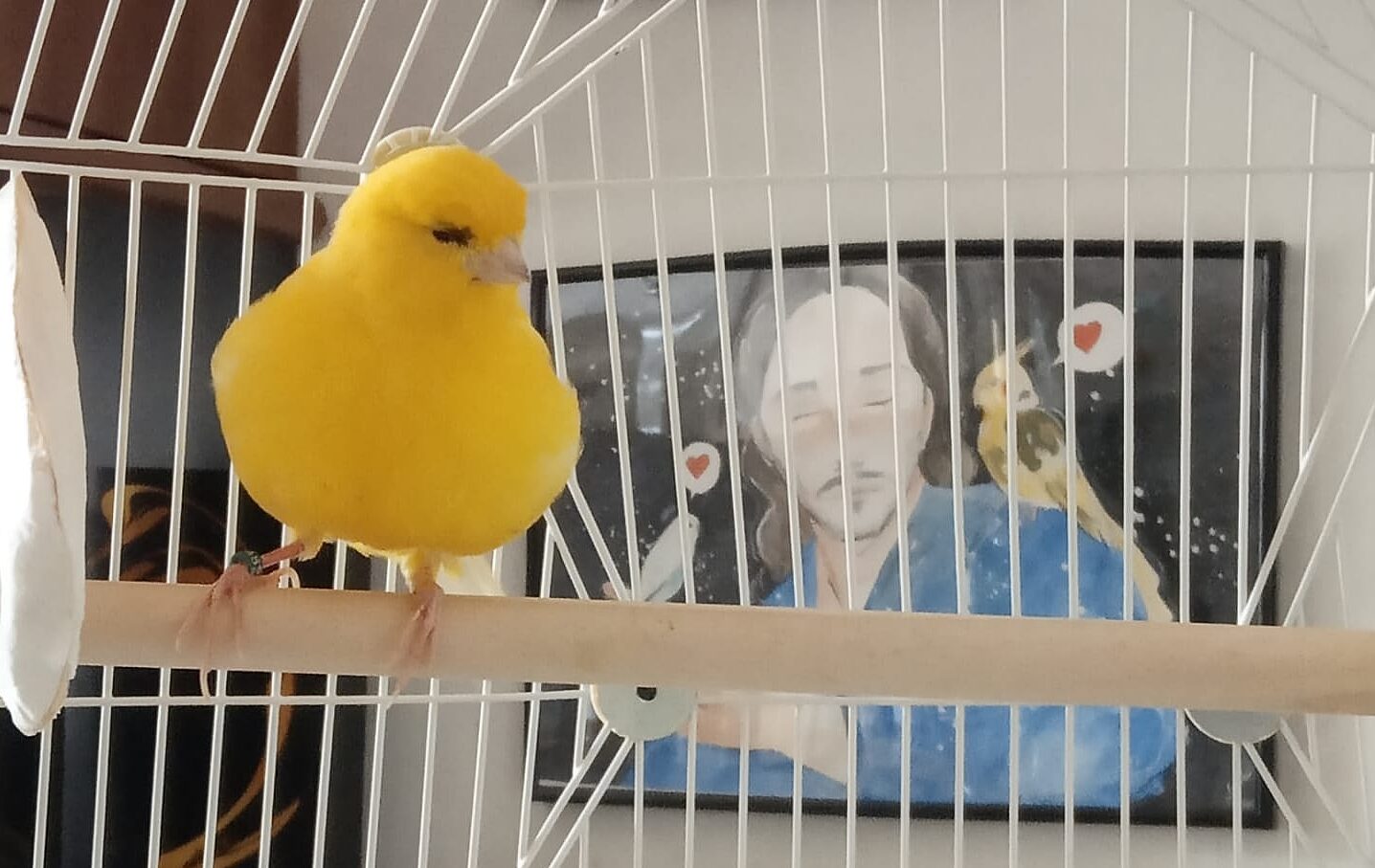
At the tender age of one, Peaky is already a retired filmstar. He had lived in a cage his whole life, released only to perform. When Joana and Fergus took him home, he was a fluffy, yellow bundle of nerves. However, they were determined to help Peaky, their cute little canary companion, to come out of his shell.
When Joana met Fergus, she didn’t know she was falling in love with a human and his pet cockatiel. It had been his best friend for 22 years. Together they grew the flock with a mischievous bird. “He was like a dog; he wanted to sleep with us. You could hold him and kiss him!” But tragically, within a short space of time, the cockatiel died of old age, and then the bird became terminally ill. The house fell silent.

Lockdown 1 without birds was quiet and sad for Joana and Fergus. To cheer themselves up, they decided to get their home ready for another bird and after plenty of research, they agreed on the Omlet Geo as the beautiful new bird home. All they needed now was a bird to live with them.
Fergus works in TV, and if anyone offered an animal, Fergus was known to take it. One day a ray of sunshine arrived on set-a bright little canary owned by a person who supplies animals for TV shows. Fergus struck up a conversation with the owner and learned that this little bird had a feisty character and had to be separated from the other birds, which meant he lived alone, probably in a smaller cage. Seeing Fergus’s enthusiasm, the owner asked, “Do you want this one?”
Ecstatic, Fergus called Joana, “We can get a canary!” When the clapper board shut, Fergus drove Peaky home to Edinburgh. Unfortunately, they got stranded en route in a massive snow blizzard and were stuck in the car for hours before being rescued by locals who took them in for the night. The next day, Peaky and Fergus continued their journey home, and when they finally arrived, the house instantly came alive.
Peaky sings beautifully and chirps up when he hears a running tap, the kettle, the hairdryer, and he even provides backing vocals to Joana’s zoom calls. However, unlike their previous birds, he’s a scared soul that feels safer inside his Omlet Geo.
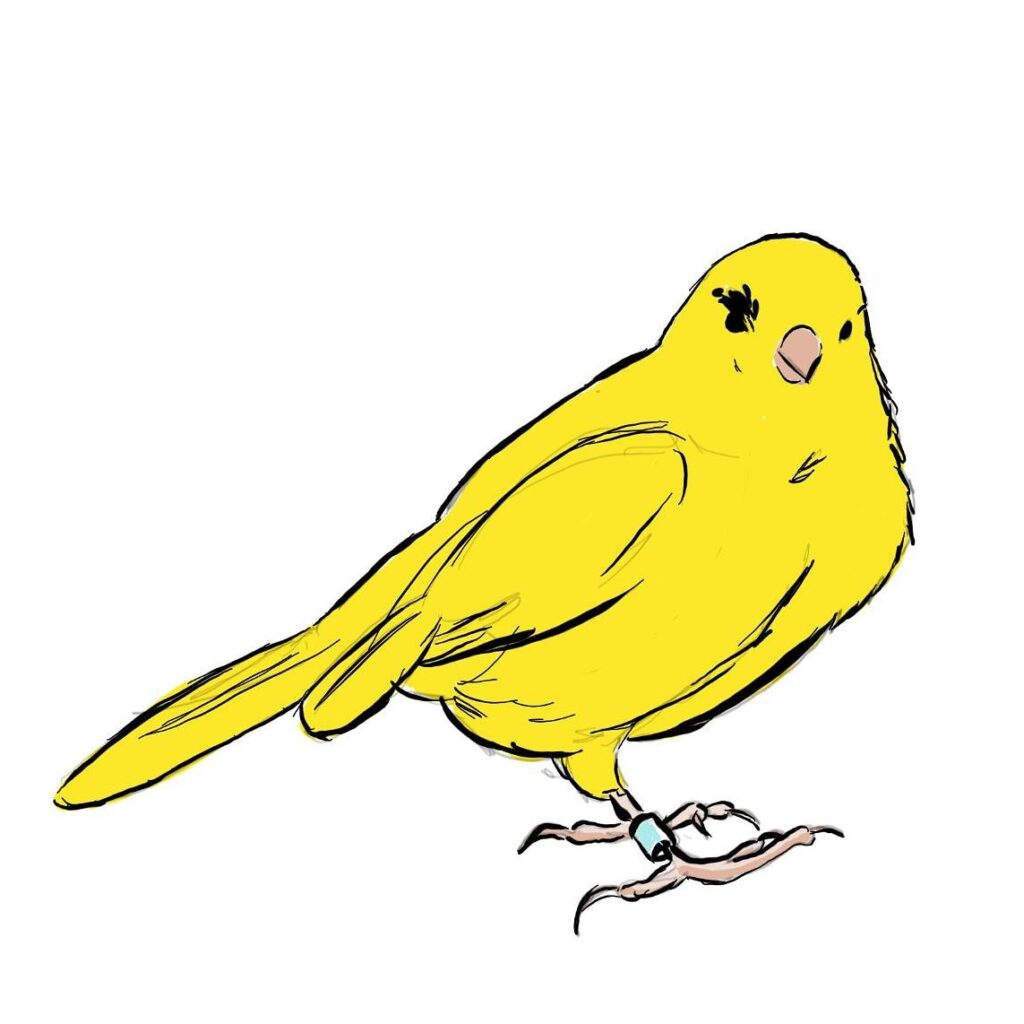
He doesn’t want to come out. Joana understood it would take time to get to know him.
She has a deep empathy with birds and is slowly, patiently, gently, working with Peaky to get him to trust his new human family. When she was younger, she made magazines written from a birds point of view called The Birds Club. Joana is now a professional writer, currently working on a series of children’s novels where birds play the main characters. Peaky even has a little cameo.
He’s getting braver, occasionally eating treats from Joana’s hand, enjoying honey seeds, millet and spinach. Joana makes sure he has space to escape if he’s not comfortable. She doesn’t want him to perform, she just wants to prove to Peaky that he can trust her.
“I’m doing a lot of research to work on rewriting his ideas about us. He came into our lives after being birdless for a year. He has no idea how happy he makes me.”


This entry was posted in Birds

This article is a part of our Pride of Omlet series, a collection of amazing stories which shine the spotlight on extraordinary pets and share their selflessness, bravery, talent and compassion with the world.
-Written by Anneliese Paul
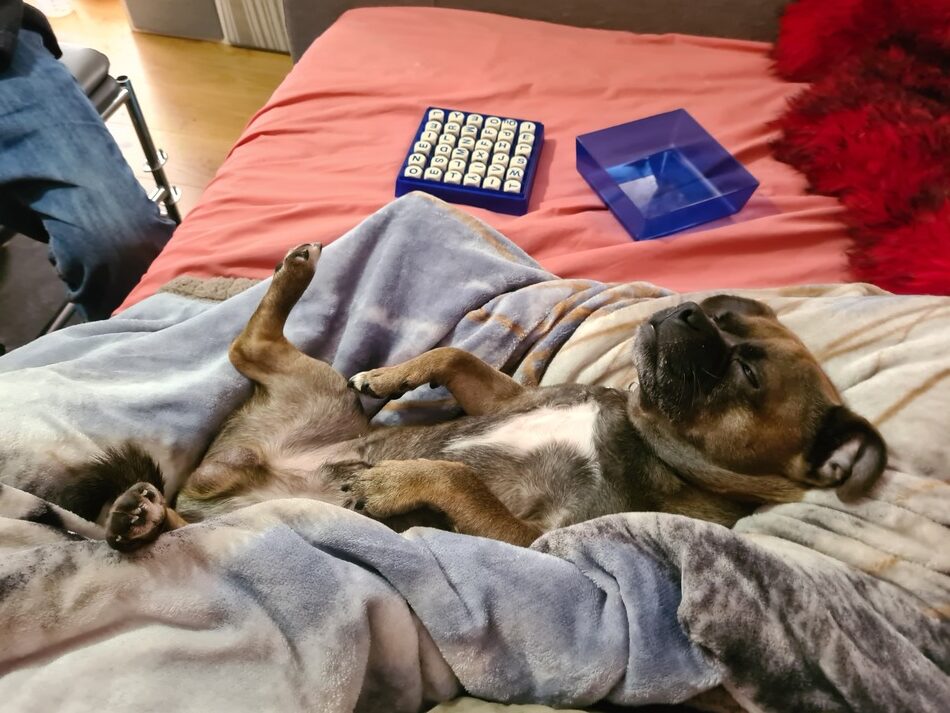
Mipit is a Mental Health Assistance Dog for his human, Henley. Mipit keeps Henly alive and independent. Who wouldn’t love a dog that can put out your recycling, answer your phone, and be your best friend, come rain or shine?
Six years ago, homeless and experiencing mental health crisis, Henley was given a glimmer of hope when she was offered a flat. She reconnected with her mum and dad, and slowly, life started to improve with their help. But something was missing. Henley needed a companion.
Henley’s autistic and always wanted an autism assistance dog, but by now, Henley was too old to apply. One day, Henley and her mum went to get their hair cut. The hairdresser suggested they go to the nearby pet shop to ask if they knew of any puppies; the pet shop gave her two phone numbers. As Henley was leaving the shop, she spotted a leaflet on the window about Mental Health Assistance Dog training.
Henley called the breeder’s numbers and soon after brought home her first puppy. A jug (Jack Russel cross Pug) she named Lottie. First, she began training with the Kennel Club good citizen dog scheme and then assistance dog training with Darwin Dogs. But at six months old, Lottie was attacked by a pack of six dogs, and Henley decided to stop her training to give her time to recover. With Lottie better, Henley felt it would be good for her to have a friend. So she called Lottie’s breeder to see if any more pups were on the way. Luckily Lottie’s grandmother was pregnant, and when the puppies were born, Henley went to visit and brought home Mipit.
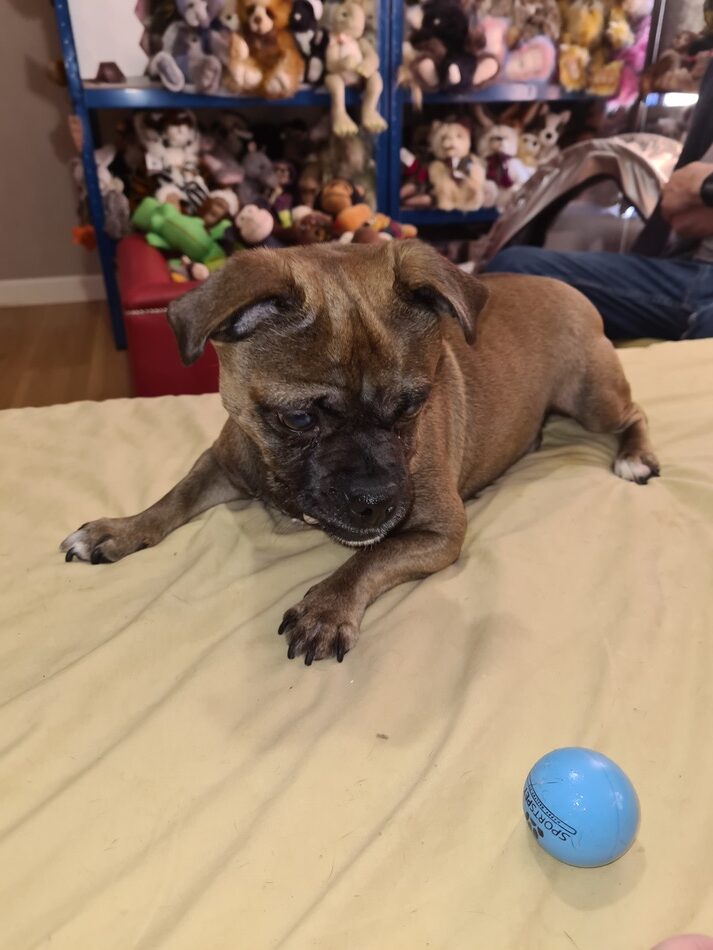
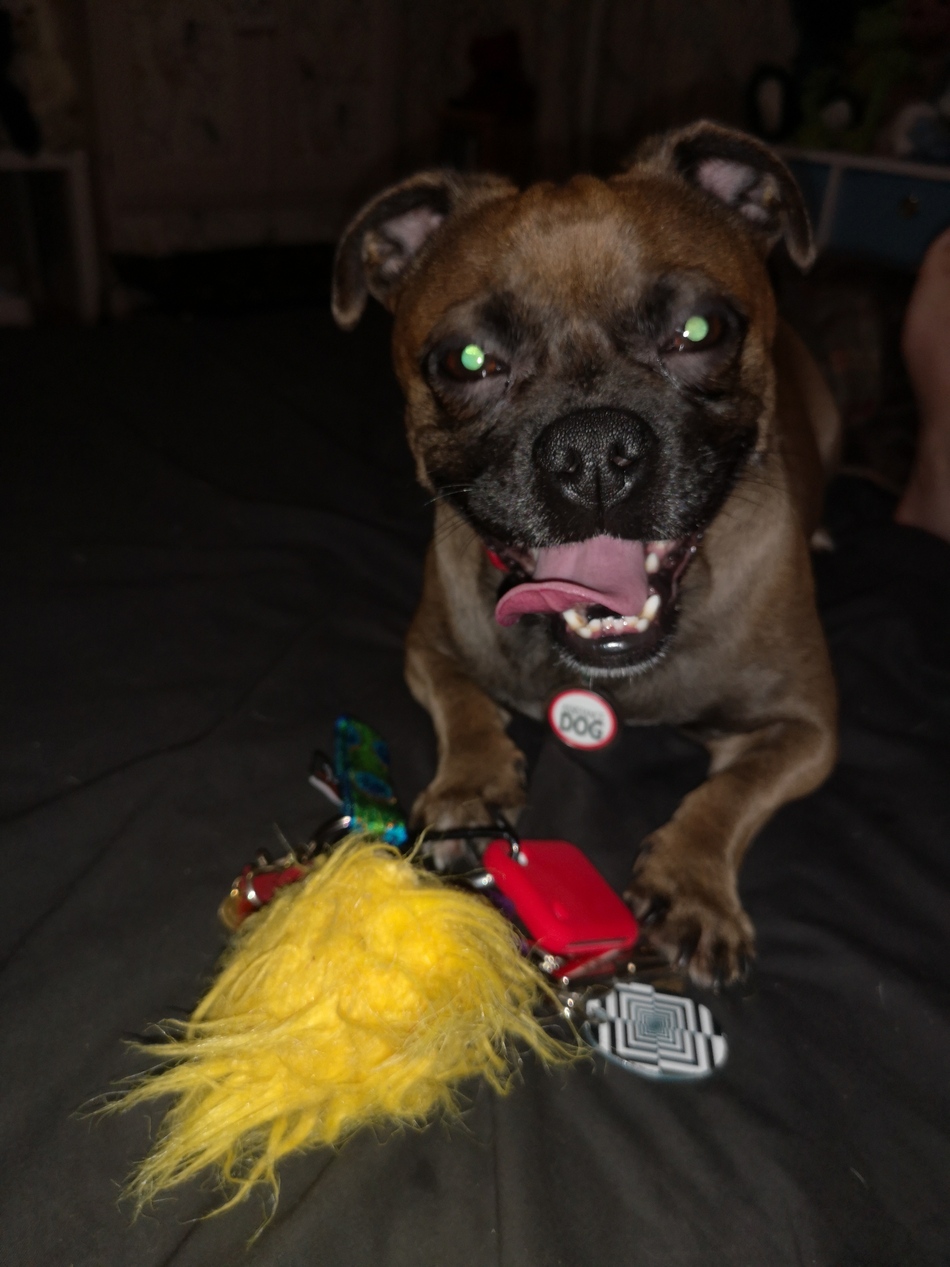 Mipit’s a Jug like Lottie, who Henley chose for his rebellious nature, but despite wayward first appearances, he’s proven to be intelligent, loving and loyal. Within a few weeks, Mipit was doing things that Lottie had taken months to learn, and Henley decided to focus her assistance dog training with Mipit.
Mipit’s a Jug like Lottie, who Henley chose for his rebellious nature, but despite wayward first appearances, he’s proven to be intelligent, loving and loyal. Within a few weeks, Mipit was doing things that Lottie had taken months to learn, and Henley decided to focus her assistance dog training with Mipit.
He flew through both bronze and silver Kennel Club assessments by the age of one. He was too young to start gold, so Henley started assistance dog training. In under two years, he’d completed all three levels. Lottie had taken the same time to complete only one. Mipit’s instinctive with training. “He can see into the future,” says Henley. “It’s like he already knows before you’ve trained him.”
Henley uses a wheelchair and Mipit is always beside her, ready to help. He opens doors, picks up the phone and takes out the recycling. He does things to make Henley laugh, like playing hide and seek under the duvet. He never turns off. Mipit’s training with Darwin Dogs is unlike any other assistance dog training. Henley has developed a partnership with him to train him in three special skills that are unique to her needs.
Mipits first special skill is to lay flat on Henley’s knee, giving deep pressure therapy to help with the pain she has in her legs. Secondly, he’ll fetch and retrieve anything up to his own body weight. His third skill is a showstopper. If Henley’s been upset anywhere, Mippit will sing to her to help her recover. He often sings Henley out of Sainsbury’s to get her ready for the journey home, and Mipit has become known for his singing in their home town. Sometimes Henley is stopped by people asking, “Are you the one with the singing dog”, and Mipit will gladly give a little performance.
Last year Henley lost her mum. This was devastating for Henley’s mental health. Both Henley and her Dad, Chris, credit Mipit with keeping them a team, working through difficult times and keeping their bond strong. “He forces us to be together in a lovely way. He’ll cuddle Dad and bring him to me. He dives up and gives me kisses when he knows I’m poorly.”
Mipits unconditional and constant devotion to putting a smile on Henley’s face gets her ready for the day, every day. With the help of Mipit and Lottie, Henley hasn’t self-harmed in six years and now lives in a bungalow with a garden with six chickens for company. Soon two rabbits will be joining their extra special support bubble.
Henley’s dad Chris says, “I watch Mipit because he picks up on Henley’s mood. When she’s not feeling good, he moves closer. It gives me comfort to know Mipit is looking after her. He’s a cracking little chap.”
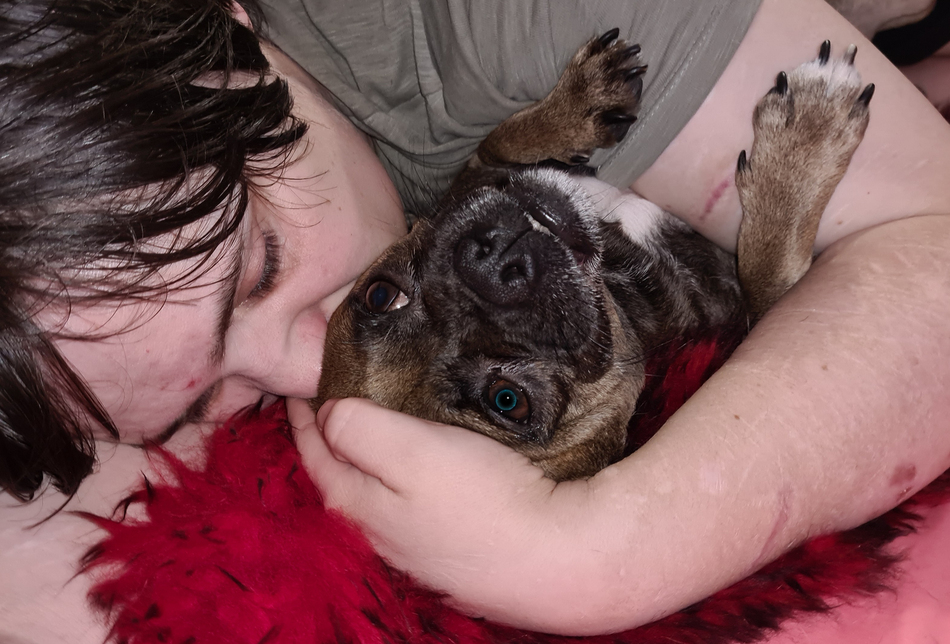
This entry was posted in Dogs
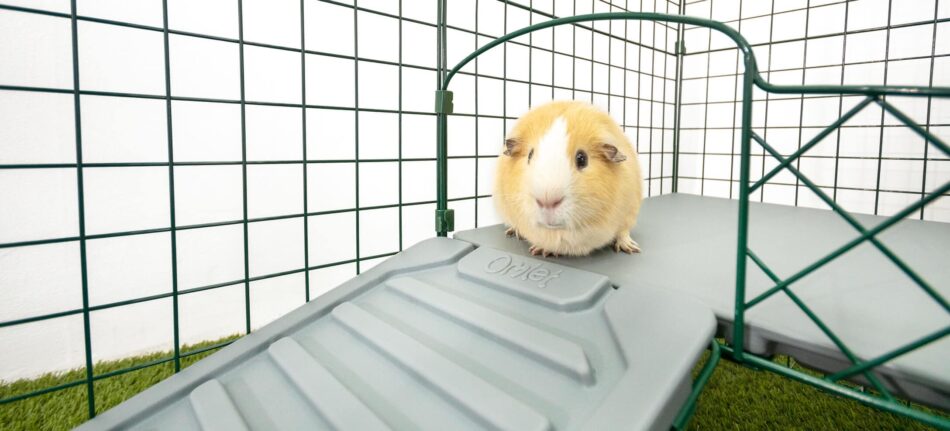
Guinea pigs are highly social animals that thrive on companionship and stimulation. And since a happy guinea pig is a healthy guinea pig, they need plenty of mental and physical enrichment. Toys, treats, and a playmate are just some of the key elements to enriching piggy-play.
Playtime is best spent with pals! If possible, consider adopting guinea pigs in same-sex pairs or trios. Guinea pigs thrive on social interaction, and do best when they have friends that speak their own language! If more than one guinea pig is not an option for you, be sure to engage yourself in piggy-playtime every day. Take note of what your guinea pig likes to do – are they curious and outgoing, or laid-back and shy? Do rolling balls catch their attention? Or do they prefer to chew rather than chase their toys? Knowing each guinea pig’s personality will help create the most enriching environment possible.
Serve food interestingly
Were you ever told not to play with your food? Well, the same rule does not apply to cavies! Mealtimes are a great opportunity to sneak in play and bonding time. Our Caddi Treat Holder is a fun and unique way of serving up your guinea pig’s meals and treats. Making food challenging to reach means more mental and physical reps before reward, and has the added bonus of keeping treats up off the floor. You can also hide food to encourage natural scavenging behaviors in your guinea pig. Place treats in paper tubes, or a hay rack for rummaging fun! Be sure to surround treats with nutritious hay to ensure meals are eaten before dessert!
Guinea pigs can also be fed by hand, but be sure to only offer treats long enough to keep your fingers out of accidental-biting range! Hold treats loosely between your fingertips and release as soon as your piggy has a hold of it.
Another interesting and engaging way to serve food to your cavies is by threading fruits, veggies, or herbs on a rope or skewer stick fastened with knots or clothespins. Be sure that the twine or rope is thick enough to avoid getting knotted around your piggy, and not so long that they can get themselves entangled. A blunt, metal grilling skewer secured to the side of your guinea pig’s enclosure is both chew and tangle-proof.
Guinea pigs are very food motivated, which makes exercising much easier! To give your piggy some extra steps for the day, tie some of their favorite food or toys to the end of a string and drag it along the floor for them to chase! Keep it just out of reach to encourage them to keep after it. Just be sure to let them catch their prize within a reasonable timeframe!
Changing up the menu from time to time helps alleviate boredom while enhancing your guinea pig’s health. Choose seasonal, piggy-friendly fruits and veggies such as melons, apples (without seeds!), or summer squash to add variety to their diets. Guinea pigs are also excellent lawnmowers, and would love time outside to help with the grass! Place them in a secure guinea pig run to move around each day and you’ll be amazed at how much less you’ll need to mow!
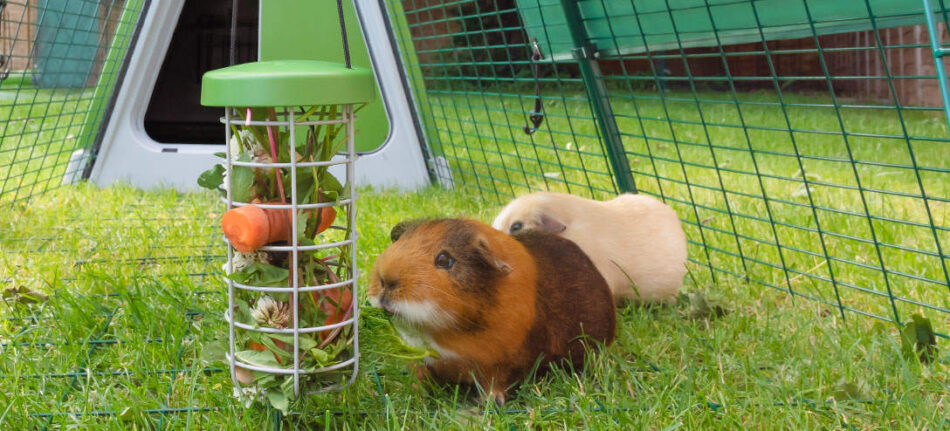
Obstacles, tunnels and tubes
Did you know that wild guinea pigs utilize the burrows and tunnels of other animals? They aren’t known for digging themselves, but they love to spend time in the safety of pre-dug tunnels! As prey animals, they have excellent eyesight – especially toward the sky, scanning for owls and hawks. Guinea pigs thrive in areas with lots of cover supplied by tubes and hideouts. Our Zippi Guinea Pig Tunnel System and Zippi Guinea Pig Play Tunnels allow for hours of play for your piggy and viewing enjoyment for you! Watch your piggy zoom through tunnels (or maybe even take a nap!) and weave their way through a course of your own design. Change the configuration routinely to further challenge your guinea pig. Bonus tip: hide some treats along the way, and you’ll have one happy cavy!
Make use of those shipping boxes! Guinea pigs love a good challenge, so create an obstacle course using a combination of tunnels, tubes, and cardboard boxes. Just be sure to discourage the nibbling of the cardboard obstacles!
Vantage points
While they feel most comfortable in the safety of tubes and tunnels, guinea pigs enjoy a good climb! They’ll routinely scout their surroundings looking for dangers, so giving them an elevated space will help them feel more comfortable. This is another place to get creative! Build platforms from cardboard tubes, boxes, or add our Zippi Guinea Pig Run Platforms to your piggy’s space to add levels of fun.
Toys
Some guinea pigs enjoy carrying or pushing small toys around. Guinea pig toy ideas include: small plastic balls, untreated willow or dried grass weaved-orbs, and small stuffed toys. Specially made guinea pig toys can be found at most pet stores, or choose small balls and stuffed toys from a selection of cat toys. Ensure that any small, glued-on accents are removed to prevent your guinea pig from ingesting something they’re not supposed to! And make sure each piggy has their own toy- they may be sociable, but not every piggy wants to share their favorite toy!
You can also leave toys in their cage for them to entertain themselves while you’re away. Bird toys, or toys made for rabbits and guinea pigs can be hung from the top or sides of your piggy’s cage to provide hours of fun! Be sure to remove any bells from bird toys that are small enough to swallow. Chewing sticks made from applewood are another must-have for cage enrichment. Guinea pigs have teeth that continuously grow, and need to gnaw on wood to keep them trimmed to an appropriate length. Applewood sticks come in a variety of shapes and sizes, most of which are perfect for your cavy to carry around and gnaw on at their leisure!
Shapeable log bridges are another great cage improvement for your guinea pigs. They can be formed into hides to run under, walkways to run across, ramps, dividers…your imagination is the limit! Untreated garden edging works too – just be sure to purchase a material that won’t harm your piggy should they taste it.
Toilet paper or paper towel rolls are great for creating treat-stuffing toys, or cut them down to create pillars for homemade platforms. Wrapping paper tubes are extra-sturdy for cavy construction projects! If your guinea pig is young or on the small side, be sure they can’t get their heads stuck inside any tubes they have access to.
Moving furniture
Guinea pigs need to be kept on their toes for optimal health. Another simple way to create a new and exciting environment for them is to rearrange their furnishings every time you clean their cage or enclosure. Move around their guinea pig shelters, playgrounds and guinea pig viewing platforms, and they’ll set off re-exploring their territory with gusto!
After all of this exhausting play, your guinea pig will probably want to take a well-earned nap. Popular snooze-space options among guinea pigs are fleece hammocks or blankets. These cozy bed options will be a fast favorite with your cavy! Make sure to wash your piggy’s bed of choice in the washing machine or by hand to keep it fresh!
Accessories to avoid
Toys: Watch out for toys with sharp edges, small attached accessories that could pose a choking hazard, or harmful materials such as treated wood. Also be wary of materials such as soft rubber or plastic that pieces can be bitten off of and swallowed.
Exercise balls and wheels: While guinea pigs may look like large hamsters, their anatomy is quite different. Guinea pigs are not comfortable in an exercise ball or wheel, and can seriously injure their backs or feet if placed in one. Ventilation is also important for guinea pigs, and exercise balls in particular do not allow for enough airflow to keep your piggy cool.
Bridges: Guinea pigs are adorable, but not graceful! Make sure all provided bridges either have rails to prevent accidental falls, or are low enough to the ground or level below them to provide a safe place to land.
Leash/harness: A walk may sound nice, but even the most friendly and trusting guinea pigs can panic on the end of a leash. Cavies are “flight” animals by nature, and will harm themselves struggling against a harness or leash if pulled on. A better option would be playing the string-drag game mentioned earlier, or a snuggle session on the couch with their favorite human-friend!
Creating fun games and environments for your guinea pig is rewarding for both of you! Playing with your piggy builds trust, and there’s no faster way to their hearts than through food! By treating them often, playing even more often, and giving them ways to entertain themselves while alone, you’ll ensure they’re living their best life!
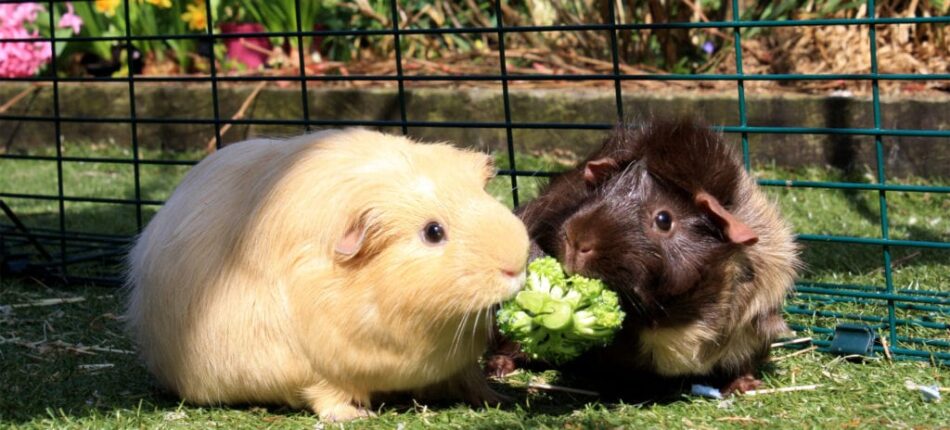
This entry was posted in Guinea Pigs
Birds are extremely affectionate pets that love to thrive in a family environment. You don’t need to be a bird expert to keep a small bird under your roof. However, if you want it to thrive and be happy and healthy, there are a few things to consider.
Omlet offers you a list of 5 things to keep in mind when raising a budgie.
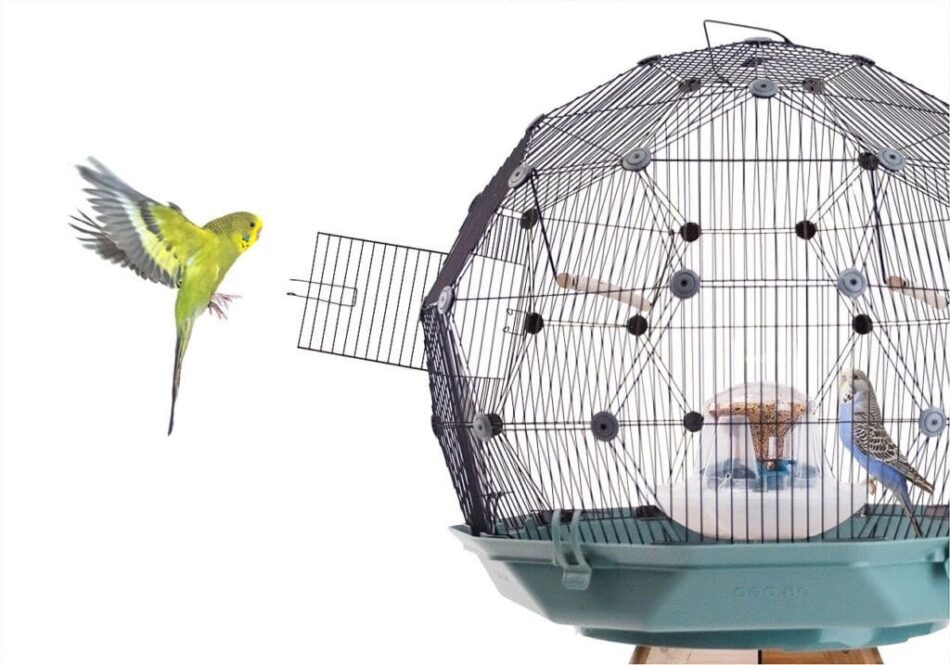
1- Consider investing in a cage that respects your pet and its needs
If you decide to adopt a bird, this should be a priority. Make sure you have a cage that meets your bird’s needs and allows it to be happy. A bird needs enough space to stretch its wings and have fun. Make sure the cage is large enough and that it gets enough sunlight. Your bird will need to see light to be able to thrive.
Budgies fly horizontally and do not fly high, so make sure the cage is wide enough.
It is important to choose a cage that is easy to clean, as you will need to spend time keeping your bird’s area clean. This is essential for your bird’s health (and yours). Budgies need to relieve themselves on a regular basis, approximately every 15 minutes, so you need to have easy access to all areas of the cage so that you can clean the entire cage and avoid unpleasant odors and a dirty environment for your little budgie.
You should also consider a cage that can accommodate several birds. Although birds can be kept alone, they do prefer the company of their own kind.
The Omlet solution: The Geo Cage
The Omlet Geo Cage for Budgies, Finches and Canaries complies with current regulations to provide your pet with the space it needs. Its innovative design provides a safe and airy living space for your budgies. This cage is the result of many years of research to provide your birds with an optimal environment to keep them happy.
This cage not only meets the needs of your budgies but is also functional and can be cleaned quickly and easily. The inside of the cage will be as good as new after your visit. In addition, The Omlet Geo Cage for Budgies, Finches and Canaries offers an exceptional design that allows it to be integrated into any interior decoration.
The cage is extremely important, as is its location. Remember to place the cage in a room with stable temperatures: not too hot, not too cold. Also avoid rooms that are too noisy with too much traffic and activity. Your birds need peace and quiet. A bright room will make your little bird happy. However, avoid placing the cage too close to windows, as the sun through the glass and the intense heat can be dangerous, or even fatal to your pet.
2- Don’t skimp on accessories
Taking care of your bird is not only about giving it a place to sleep, it is also about allowing it to have fun and discover many things through a variety of accessories. The bathtub is not a trivial accessory: budgies love to stay clean. There are many plastic tubs available that allow your bird to clean itself and feel clean all the time. Choose a bathtub that fits your cage and can easily be installed in it. It should be easy to fill from the outside.
At Omlet, we offer a Geo Bird Bath that fits our Geo cage and its sloping sides perfectly.
Technique for the bathtub: do not fill it to the brim, as you will find water everywhere. The tub should not be too small to allow your bird to enjoy it fully, but it should not be too large either, so that it does not take up all the space in the cage. If the bathtub you have chosen fits easily into your bird’s cage, you may want to consider adding it for a few hours while your bird takes a bath and removing it the rest of the time.
You should also consider quality drinkers and feeders that will allow you to feed your beloved animals properly and without hindrance.
If your bird can clean itself and stretch its wings, it is likely to thrive and feel happy. However, it is necessary to keep it occupied with toys.
So think about furnishing its space with useful accessories that entertain your budgie. Vary the shapes, sizes and aspects to offer your pet new experiences.
Perches for birds are extremely important for your birds and play a significant part in ensuring a better lifestyle. Choose perches with a wooden base, such as pine, as plastic fails to offer the proper grip that your bird needs, and can be bad for their feet.
Bird toys have their place in your pet’s cage, but avoid taking up the whole space. It is important to have several types of toys that you can mix up on a weekly basis to give them more variety and keep your bird entertained.
Toys stimulate your pet and prevent your bird from getting bored.

3- A happy bird is a well-fed bird
There are several ways to take care of your bird and the first way is to feed it sufficiently with quality food. What does a bird eat? Your birds’ favorite foods are seeds, vegetables and fruit. Just like other animals, dogs, cats (etc), never give your birds chocolate and caffeine.
It is essential to ensure that the drinker is always full of water to keep your animals properly hydrated. Your birds will know how much water they need but it must be available to them. If the water is not drunk, it is essential that you change it regularly to prevent the growth of bacteria.
4- Birds need quality sleep!
Sleep is essential for your bird. It allows your pet to rest its body and recharge its batteries. Just like human beings, sleep helps reduce stress and promotes your pet’s learning and memory. It is estimated that a budgie can sleep between 10 and 12 hours a day. A happy budgie is one that benefits from this rest time in the best conditions.
It usually prepares for bed half an hour before going to sleep. You can improve the sleeping conditions of your bird by providing an opaque blanket, which does not let light in and ensures that your bird gets the rest it deserves. This solution also allows you to soundproof the cage a little if there is regular activity in the room. It is sufficient to keep the room dark and to let a little light through so that your birds are not injured if they hear a noise that wakes them up. The Omlet Geo Bird Cage Cover offers your birds an ideal solution for a full and restful night’s sleep. It can be placed on any cage and allows your birds to sleep safely.
Establish a routine each night so that your birds feel comfortable and understand when it is time to go to bed. They will feel confident that there is nothing to worry about and will fall asleep peacefully.
However, if you notice that your bird(s) panic when you put the blanket on the cage, don’t persist. Some birds have their own habits and there is no point in insisting on certain accessories. If your bird is happy and can sleep perfectly and peacefully without a cover, that is the main thing.
5- Give your bird lots of love and get it used to its environment
For a bird to be happy and healthy, nothing is more important than the love you give them in a healthy environment adapted to their needs. Never rush your bird and give it time to adapt to any situation, new environment, new toys or accessories…
Don’t hesitate to talk to your bird and make it feel your presence without smothering it. Repeat its name to get it used to the sound and to assimilate it. If there are several of you in the family environment, introduce the members of your family little by little without rushing your pet. No loud noises or big movements. Your friends or family can enjoy your bird, but in a calm and respectful way.
Treats and time with your pet will make your bird happy. Make sure you spend time with your bird. This will strengthen the bond between you. Gaining your pet’s trust is a long-term process. You can use your fingers to tame your pet little by little, for example by moistening them and placing seeds on them. Intrigued and curious, your bird will surely come to you.
Do not hesitate to open the cage from time to time to let your bird fly in the open air in a room. Just remember to avoid bright lights that may attract your bird and end up hurting it (sunlight through a window, for example). If you decide to let your bird fly in your home, be careful with objects that could either break, or hurt your pet. The room should be secure enough to prevent your budgie from ending up in the vet’s office.
An unhappy bird may become aggressive or develop health problems. This can manifest itself in regular pecking or screaming. Your budgie, if unhappy, may be more agitated than usual. If you are sure that you have done all you can to keep him happy and his aggressive behavior persists or you detect abnormal problems, it is time to make an appointment with the vet. In fact, one visit per year to the vet is recommended to check that everything is going well with your pet.
With all these tips and tricks, your bird can be happy and thrive by your side. All you need is patience and the right equipment and accessories for your pet’s needs.

This entry was posted in Birds

This article is a part of our Pride of Omlet series, a collection of amazing stories which shine the spotlight on extraordinary pets and share their selflessness, bravery, talent and compassion with the world.
-Written by Anneliese Paul
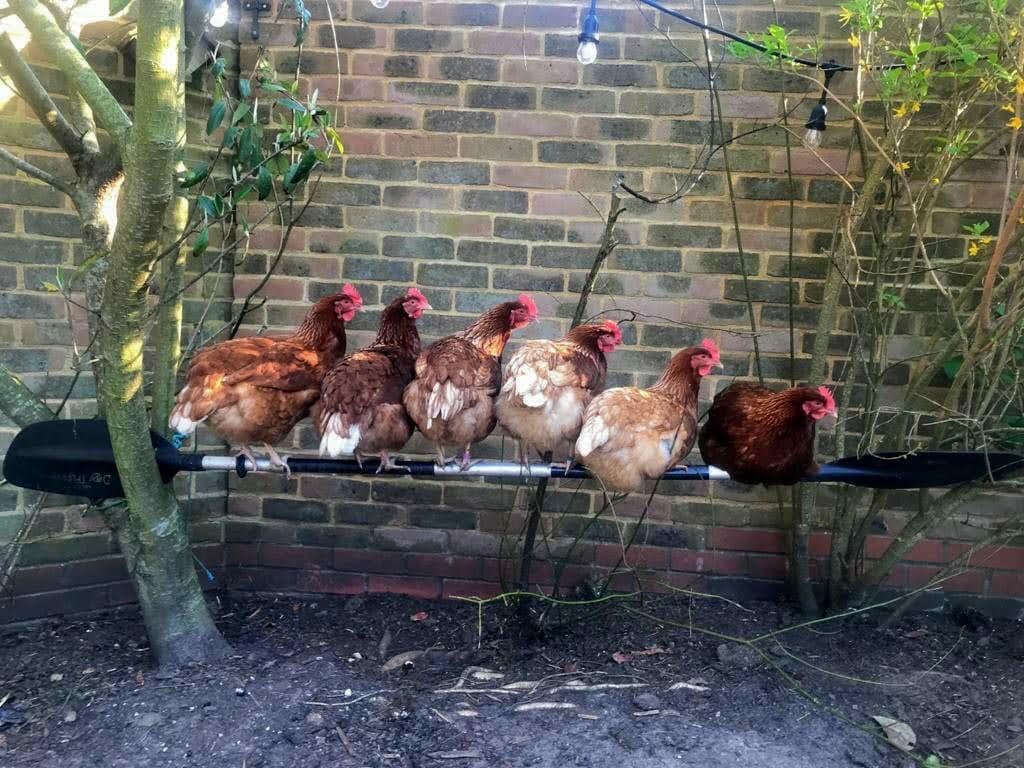
Henni Hen is a teaching assistant by trade. A cute and cuddly chicken who loves children. She follows in the footsteps of her bubbly humans, Hamish and Verity.
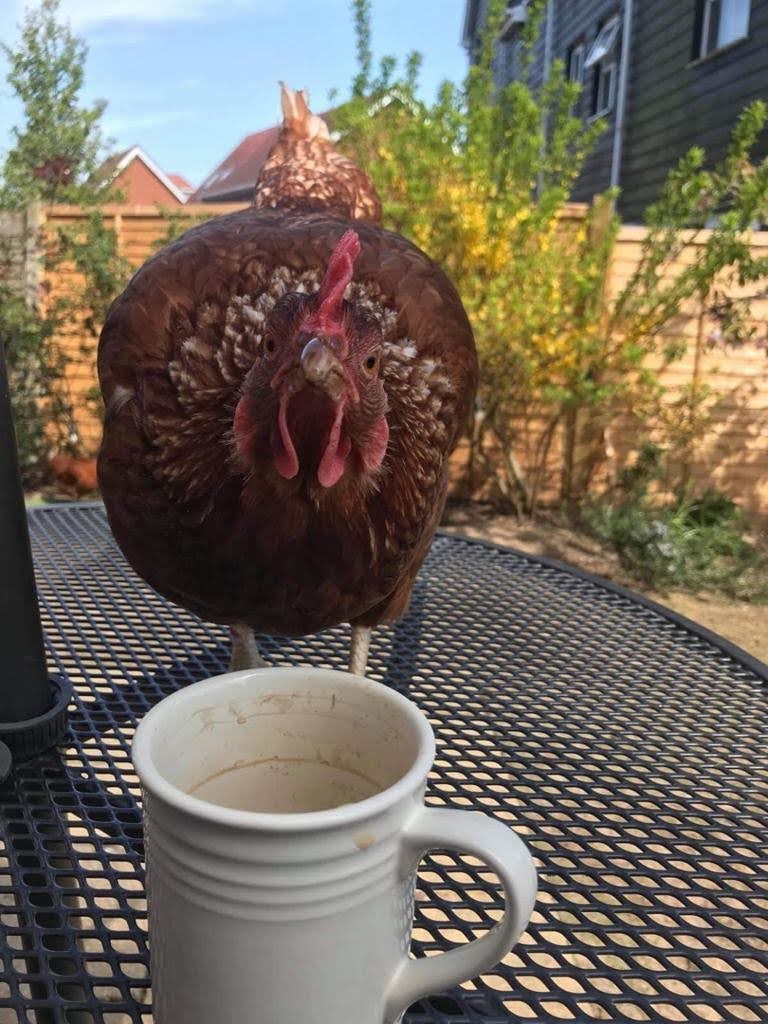
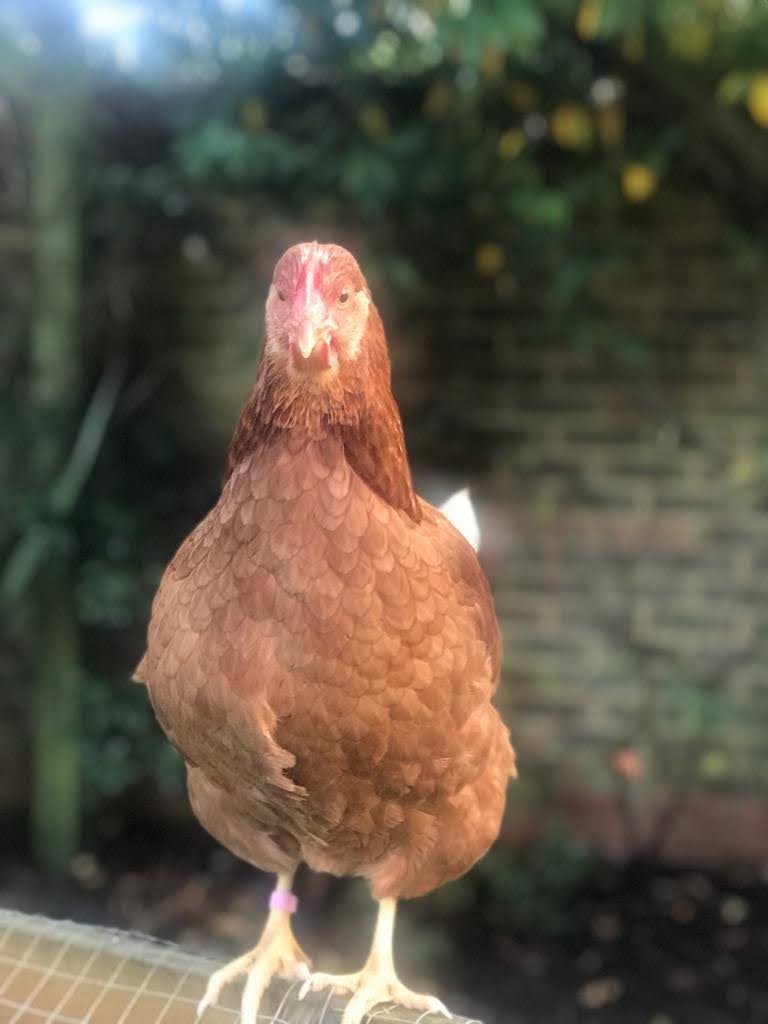
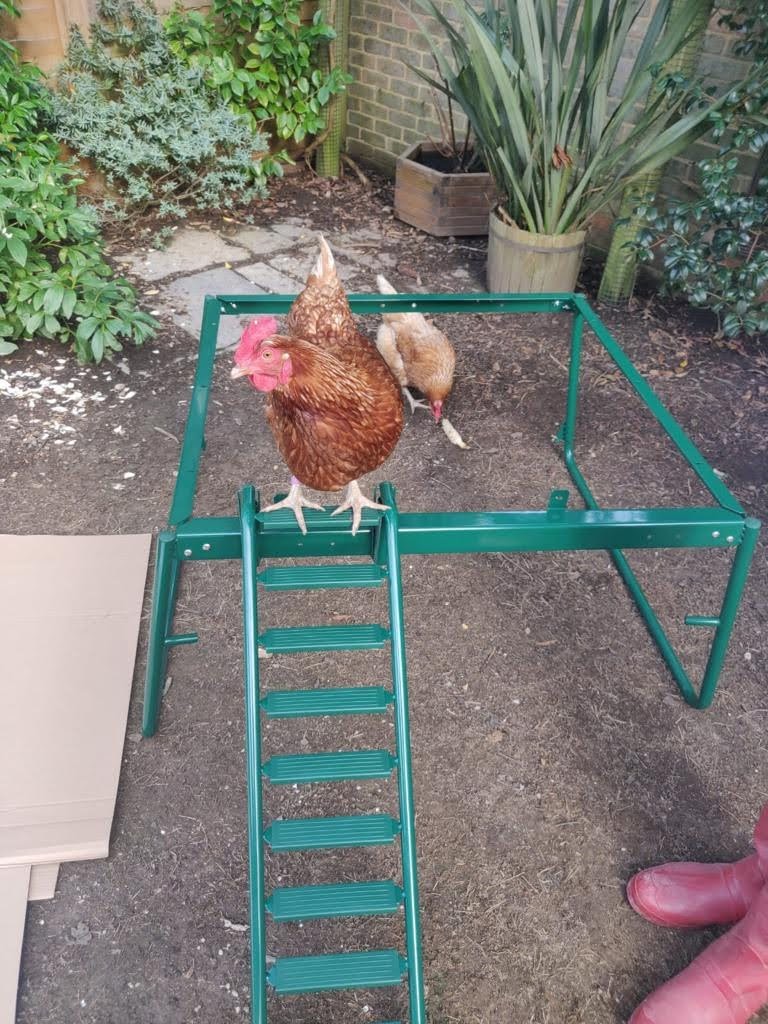
Verity hatches chicks in an incubator every year at the primary school in Kent, where she works as a reception teacher. It’s a highlight for the children in Spring, with lots of learning opportunities and fluffy little chicks make Easter even more special.
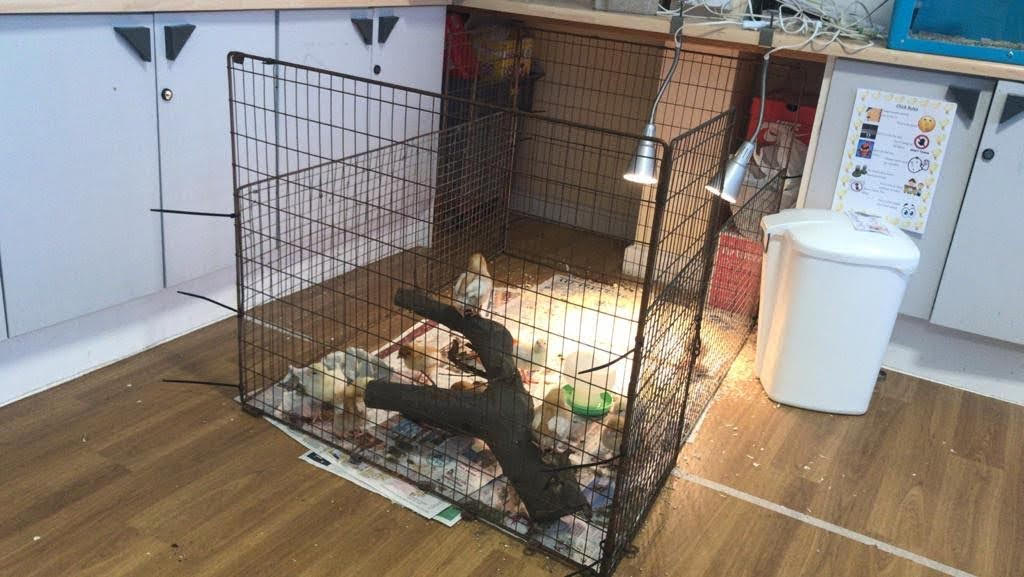
It was natural for Henni to become a teaching assistant at an early age. She was, after all, born in a school. Henni helped the children with course work and became the subject of many good literacy and science lessons.
But Henni’s talent lies in her ability to help children read. Henni can’t read herself, but children who wouldn’t usually read to an adult began taking Henni to beanbag in a quiet corner where they could get cozy. Henni cuddles up and listens patiently to her young reader, giving the odd encouraging cluck.
When Henni and her sisters became too big for the classroom’s hutch, Verity and Hamish moved into a house with a garden. Instead of rehoming the chicks with local farmers (like they usually did), they decided to take Henni and her sisters home. They’d been talking about getting a dog, but both working full-time, the chickens seemed like a good option.
Most of the time, Henni is outside, like an ordinary chicken, scratching in the garden or getting up as high as she can. But Verity and Hamish potty trained her because she loves coming into the house for a cuddle, and of course, she needs to work.
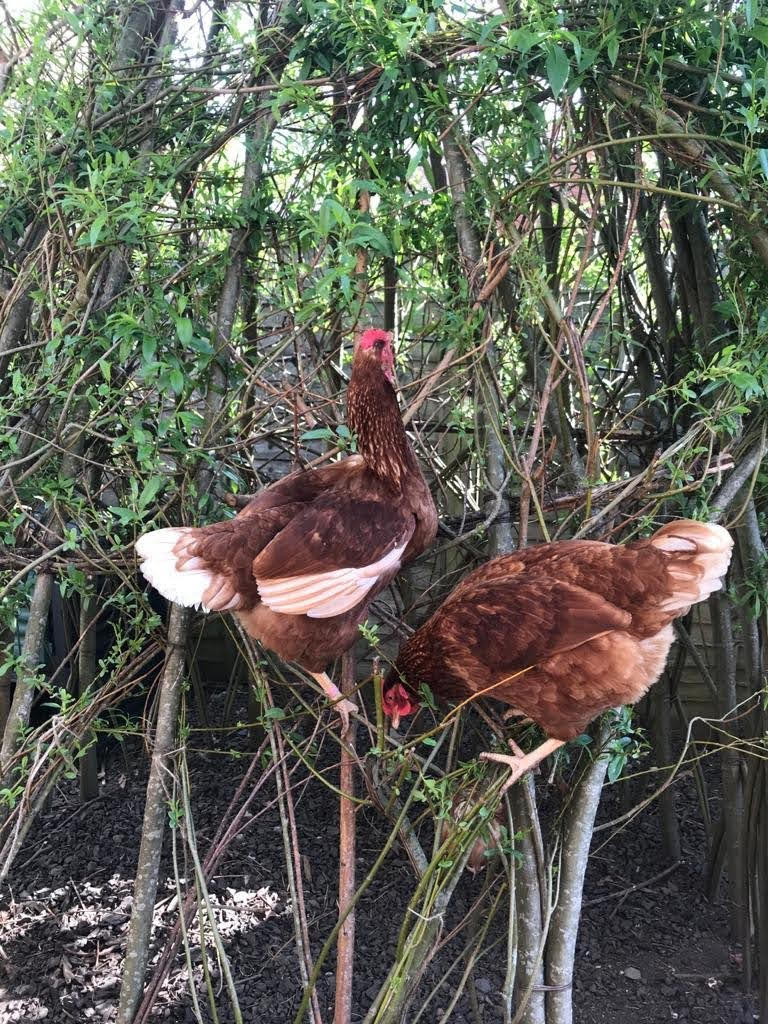
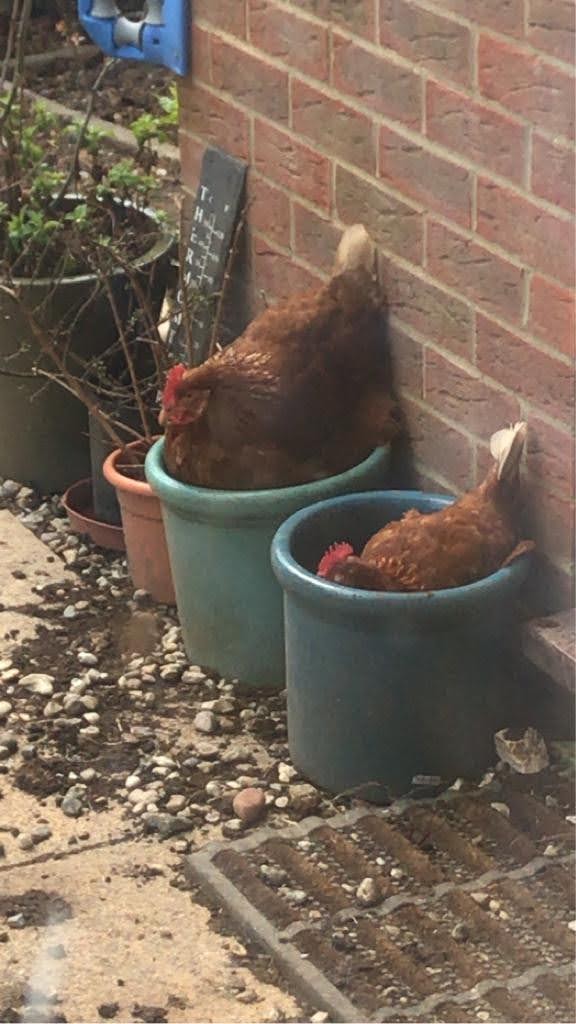
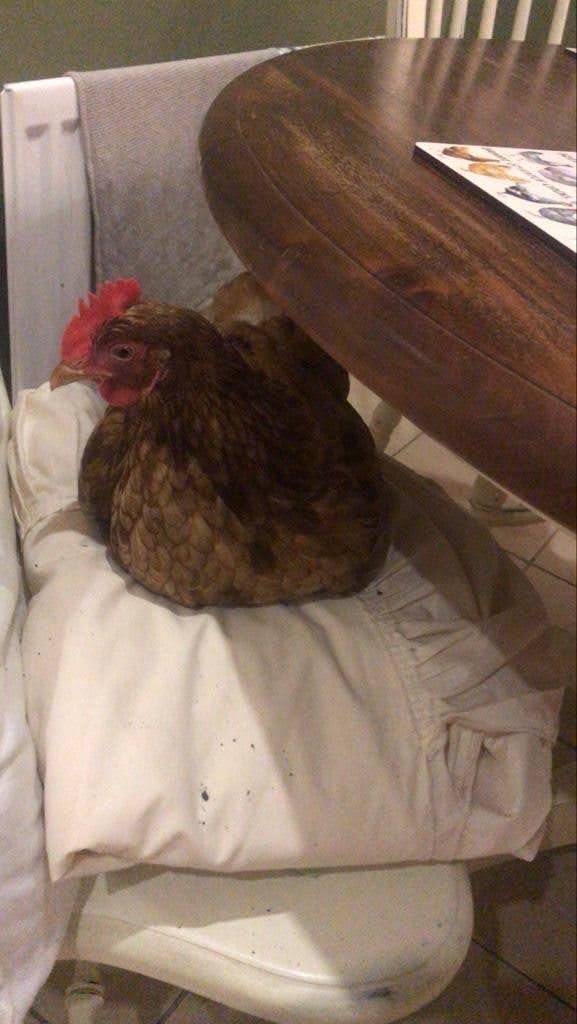
During the lockdown, the children missed holding Henni. So, Henni sprang into action and delivered both live and recorded lessons from the study that she shares with Verity. Verity read children stories, and Henni sat on her shoulder, making sure the children were listening. The principal called Verity regularly to make sure Henni’s doing ok.
Being a caring soul, Henni also gave to the community over lockdown. Together, Henni and her sisters lay six eggs a day, so Henni and Verity decided to do a doorstep delivery service for their neighbors. At 10 am, Henni would lay an egg and make a lot of noise about it, so all the neighbors knew when their eggs are ready. Then, Henni would hop onto Verity’s shoulder, and together they delivered eggs to all the houses near their neighborhood.
When she returned home, she’d often hop onto her favorite perch (the top of the garage), and the children from the neighborhood would come over to Verity and Hamish’s to see “the one on the roof!”
Henni and her sisters Megg, Gertie, Margot, Ginger, Rona and Nora used to live in a wooden coop in the garden and come into the garage in winter when it was cold, but Verity and Hamish wanted the best for them. So last year, they got a new home, an Omlet Eglu Cube, and now they’re cozy outside all year round.
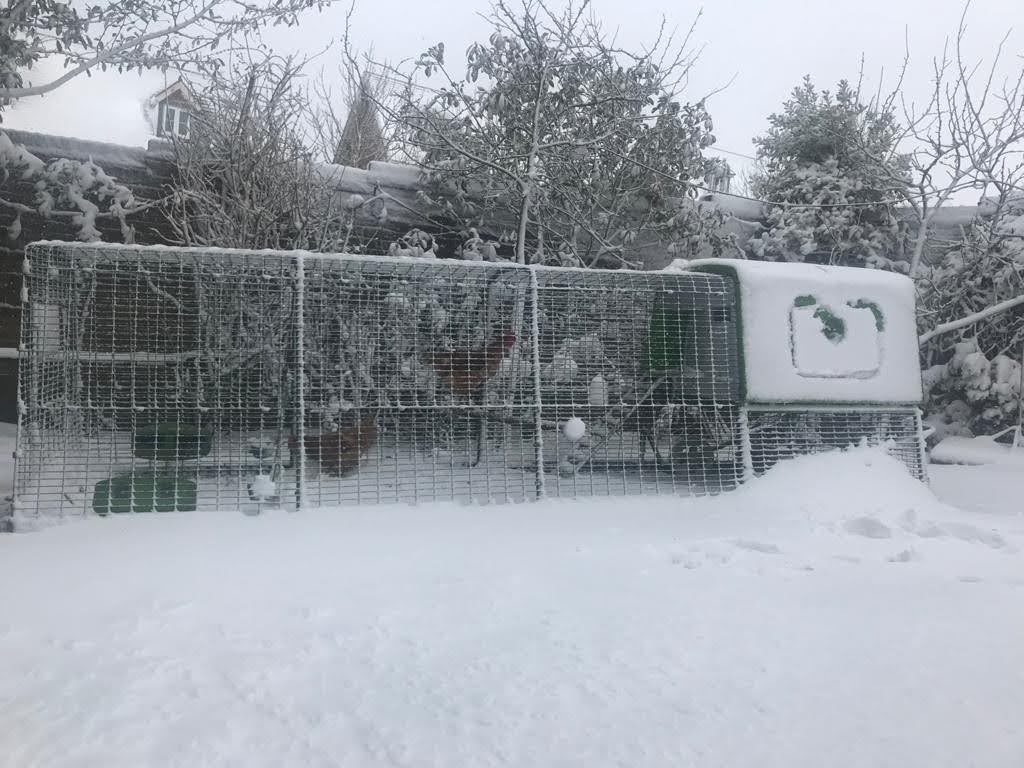
But Henni still likes to come inside for a cuddle and can often be found sitting on the sofa between Verity and Hamish for a family movie night after a hard week at work.

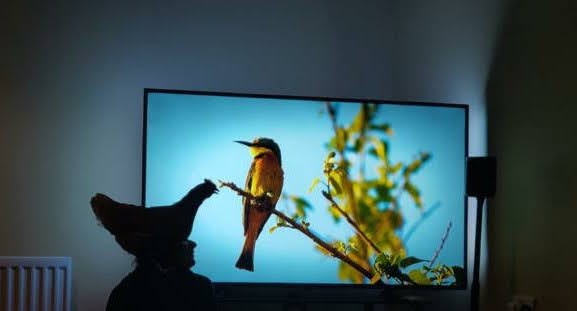
She’s just an ordinary brown chicken, and she’s low in the pecking order, but she’s got high hopes for the world. She’s very special to the children she teaches and the community she lives in, and of course, to her humans Verity and Hamish. She’s worthy of a gold star for an outstanding effort.


This entry was posted in Chickens
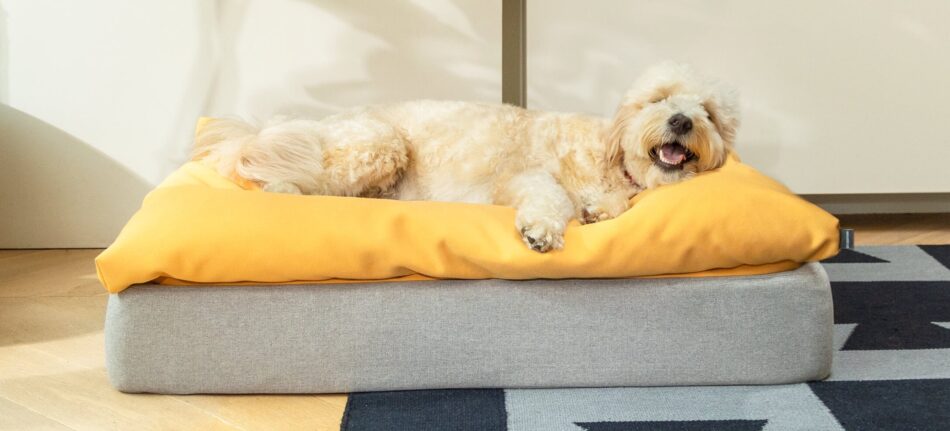
Everyone loves to stroke, cuddle and pamper their pet. Their fur is soft and warm, and stroking a dog or cat can help humans relax and destress. But despite these positives, your pet’s loose hair can invade your living space, settling on carpets, sofas, beds and furniture. It can be difficult to get rid of. So how can you avoid spending hours cleaning up after your pet?
Spring is finally here and the winter fur is starting to fall out. Avoid being overcome with pet hair and make life easier for yourself in the days to come, with the Omlet tips below…
Removing fur to help pet allergies
Do you often have red, swollen eyes, a runny nose and experience persistent sneezing? If so, it could be because of your pet’s fur. Did you know, 40% of European cats are carriers of a bacterium: Bartonella henselae? Researchers thought that this bacteria could only be transmitted through your pet’s scratch, but numerous studies have shown that the bacteria can be transmitted through fur and fleas. This is why it is important to treat your pet and wash your hands after petting it.
Pets affect the quality of the indoor air we breathe. Hair and saliva carry allergens and can cause nose, throat and eye irritation, asthma and breathing difficulties.
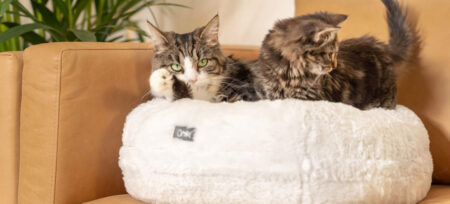
So how do you deal with pet hair?
Useful techniques to get rid of hair
Removing pet hair from your home doesn’t have to be a time consuming task. Here’s a few tips and tricks to try…
Brush your pet’s hair regularly, preferably outside, but if that’s not possible, an easy clean area such as the bathroom may be just right. By brushing your pet, you allow it to shed any hair that may have otherwise fallen onto your sofa or other surface in your home. You can gather the hair in one place and you clean it up much more easily and quickly.
Protect furniture and areas where your pet likes to lounge. Your furry friend is bound to have a special place where he likes to spend time napping and grooming, and these areas can become loose fur hotspots! Try covering your pet’s favorite patch with a towel or blanket.
The ultimate appliance: the hoover. Cleaning your home is essential in normal times, and even more so when you have furry pets. This solution seems obvious and yet it is radically effective. Choose a hoover over a broom. A broom tends to make the hair fly around and instead of getting rid of it, you move it around to other surfaces. You can also vary the end caps to suit all surfaces.
Use dishwashing gloves! An original but effective tip. Use a pair of washing-up gloves to pick up your pet’s hair in a circular motion from the desired spot. The hair will stick to the glove and can be rinsed away.
Use moisture to quickly gather the hair into small balls. Take a damp sponge or flannel and wipe the desired area. Some of the hairs will cling to the sponge while others will clump together. This method should be combined with other techniques to effectively remove your pet’s hair.
The well-known method: the adhesive roller. Using an adhesive roller is particularly effective on your clothes, especially if you do not want to wet them with a sponge. The hair will stick to the tape and lift from the material. This technique is super effective on small surfaces. However, the roller soon becomes full of hairs and it is necessary to change the roller regularly if attempting larger surfaces in your home.
Use specific brushes: velvet brushes, electrostatic brushes, etc. There are all kinds of useful brushes on the market. With a simple movement of the hand, they attract the hair to the brush and lift off your soft furnishings.
Static electricity with tights! Don’t just throw away your frayed tights, they can be reused to pick up your pet’s hair. The friction creates static electricity and attracts the hair to the nylon material.
Ventilation: renewing the air to reduce the concentration of hair in one place. Whether you have pets or not, airing your home is essential to prevent the accumulation of dust and bacteria. You will eliminate bad odors and allow for fresh air to circulate the home.
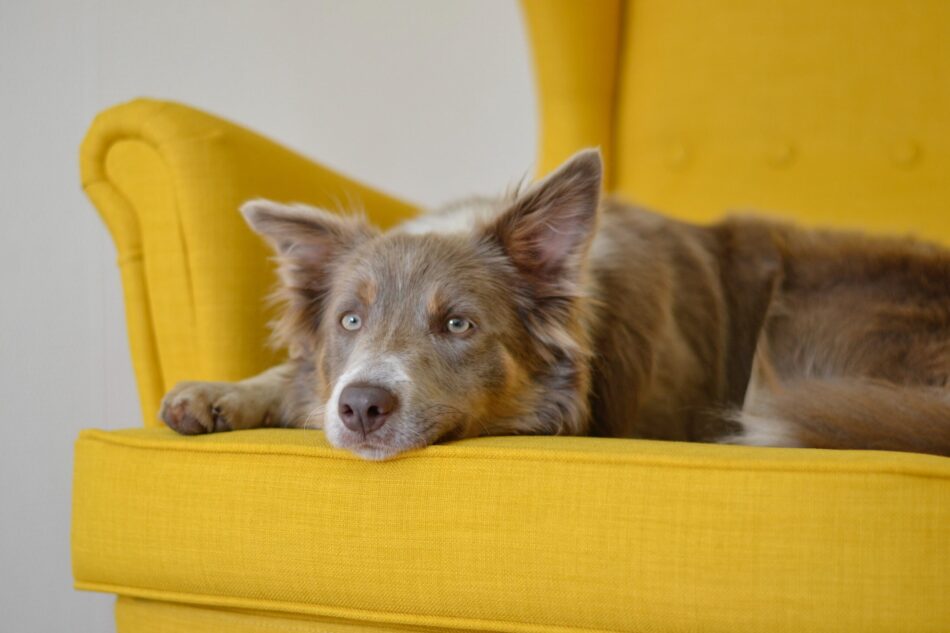
If you really need to keep an area hair-free, the most effective method will be to restrict access to your pet. It may be drastic, but you won’t have to worry about hair in your bedroom causing irritation while you try to sleep, for example.
Your pet’s fur will always be present, and impossible to eliminate entirely, however, these little tricks will help you to considerably reduce the accumulation of hair in your home and allow you and your pet to live in a healthy, comfortable and hygienic environment.
This entry was posted in Pets
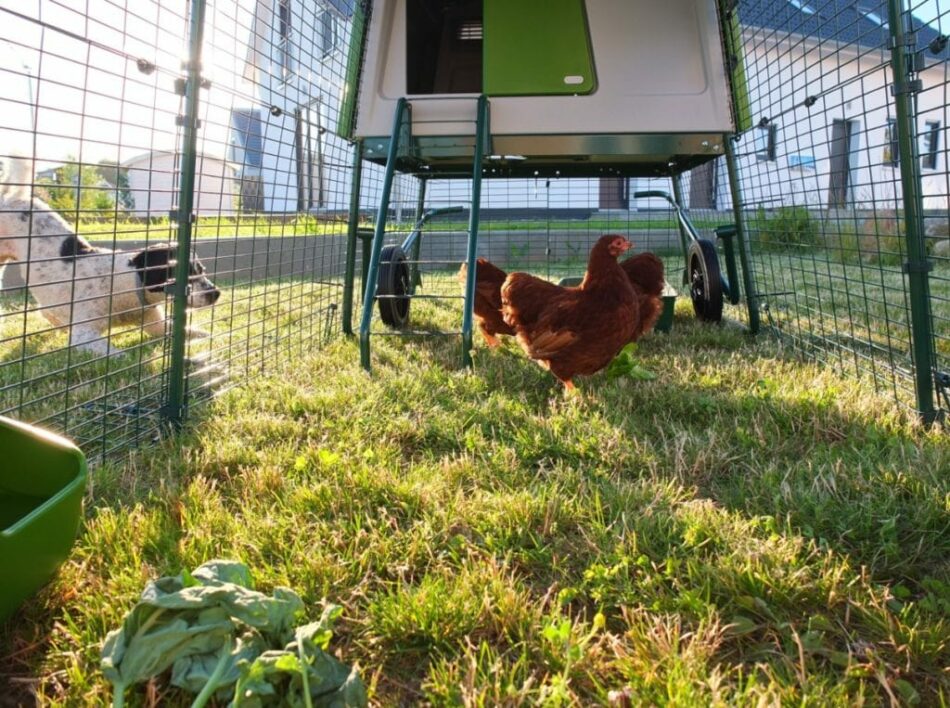
You can keep chickens with other pets when the proper preparations and precautions are in place. Some pets like cats and dogs may have an innate prey drive that chickens can trigger, so it’s important to take introductions slowly to ensure success. With these tips, you’ll be able to confidently introduce your current pets to your chickens, or introduce new pets to your existing flock with confidence.
Keeping chickens with dogs
Dogs are the most common pets in the world, with millions kept as pets across the country. So, if you’re among the many dog owners, adding chickens to your family is possible once you consider your dog’s temperament and trainability.
Assessing your dog
If you’re a dog owner, the first thing to consider is their temperament. Different dog breeds may also react differently to birds as part of their nature. For example, breeds like Labrador Retrievers or German Shorthair Pointers may become easily excited around birds due to their natural hunting and retrieving drives. Other breeds that may have increased prey drives include:
Regardless of their breed, if your dog becomes excited or overly curious around small animals, their behavior will likely carry over to chickens. If your dog loses their mind over the birds at your backyard feeder, or drags you to investigate the park ducks on your evening walks, they’ll likely stress out your flock – and themselves.
Dogs without a prey drive or with little interest in birds will likely not pose a problem to your chickens, but all dogs react differently when new pets enter their territory. Usually, most dogs will adjust to the new backyard occupants just fine after an acclimation period. You will likely see your dog expressing interest in your chickens at first – hanging around and sniffing the coop. They may even express a desire to interact with your chickens through playful postures and behaviors. Understanding your dog’s body language around your chickens will help you determine what their relationship will be like.
Chickens are prey animals, and can be hurt easily. Dogs cannot play with chickens as they would with other dogs or even other pets. It’s important to teach your pup that chickens are fragile friends – not toys or something to hunt.
Teaching dogs to get along with chickens
Unless leashed walks make your dog overly excited, their first encounter with your chickens should be done with a dog collar and lead. Make sure their collar is tight enough that they don’t slip out, but not so tight that it’s uncomfortable. Walk your dog up to your chickens’ enclosure and let them sniff. Maintain a tight leash until you see your dog’s reaction, and allow the lead more slack slowly to reinforce good behavior.
Let your dog watch you spend time with your chickens. This should be done with your chickens in the safety of a strong walk in chicken run. If your dog does more than sniff or hang around the run, take a step back and approach their interaction from a different angle.
It could take several weeks for your dog to fully accept your chickens. Some other ways to help your dogs adjust to your chickens include:
- Setting up chicken fencing around the outside of your flock’s run for your dog to observe them at a distance.
- If your dog has a run or playpen, place it next to your chickens’ run and slowly decrease the distance over several days until they are side-by-side.
- Reward your dog with their favorite treats each time they are calm around your chickens.
Make sure to never leave your dog unattended with your chickens – especially in the beginning. Even if they can’t get into the run with them, an excited dog’s barking can easily stress your flock out.
Keeping chickens with cats
Cats are more difficult to train than their canine counterparts, and are decidedly less predictable in their behavior. But the good news is that most cats don’t see a large hen as potential prey the same way a dog might. Most cat owners will agree that their cats show little to no interest in their chickens. In fact, cats and chickens have a somewhat symbiotic relationship.
Birds and their feed attract rodents, which a cat would much prefer over your hens. So, when your cat is able to patrol your chickens’ surroundings, chances are good that any potential rodent problem will be nipped in the bud.
Some cats may show increased interest in your hens. This largely depends on your cat’s breed and temperament. Cats will pose a greater threat to chicks rather than grown hens, but by keeping your flock in a strong chicken coop and run, you’ll ensure they stay safe from your cat.
Keeping chickens with guinea pigs
It may be tempting to keep some cute cavies in with your chickens, but in reality it’s not wise. Chickens will likely pick on them, and with their short legs, guinea pigs can’t get away from them quickly. Their dietary requirements are also very different, and your chickens may eat your guinea pigs’ food in favor of their own, which means neither animal will be getting the nutrients they need. If you have cavies and want to house them near your chickens, it’s best for them to have their own guinea pig hutch and run.
Keeping chickens with rabbits
Rabbits on the other hand are fast enough to fend for themselves against chickens, and if raised together from a young age, can do well around chickens. Still, they require their own dietary needs and clean sleeping quarters. They don’t roost like chickens, so they’ll need their own burrowing space in the run or under the coop.
The easiest way to achieve this is by adding walk in chicken run partitions. This will allow you to create “rooms” for each species to ensure they all get what they need. You can open the partition doors to allow everyone to be together whenever you’d like, or create a third space as a common area.
Remember to try to give each species as much space as possible in their respective areas to make them feel safe and comfortable.
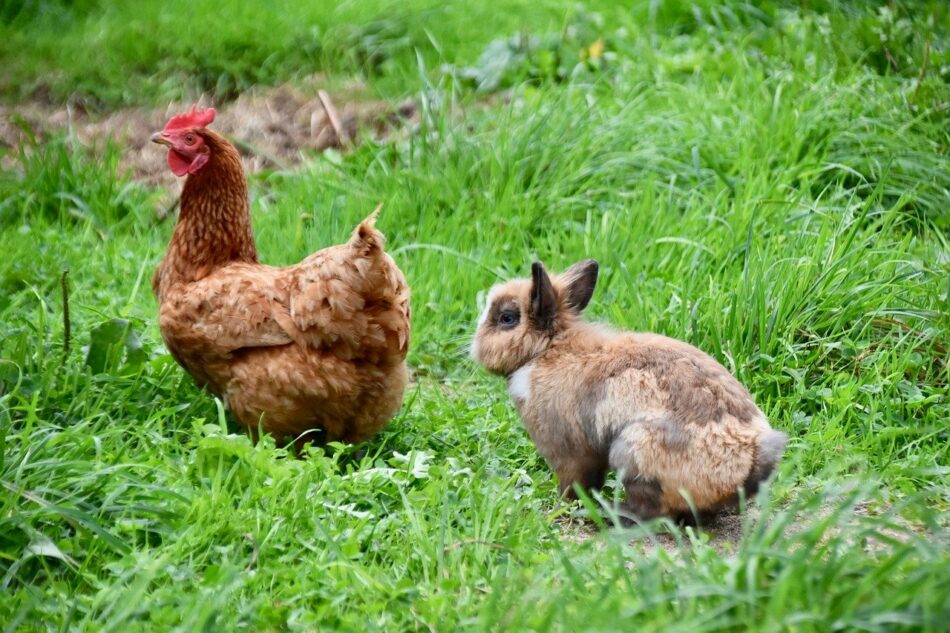
Chickens and other pets
Chickens can also mix happily with goats, and with female ducks (males will tends to bully them). Ironically, they do not mix with birds in an aviary. They will eat anything that falls to the aviary floor, but they will also happily peck the other birds whenever they can and may attract rats and mice, which will cause problems for the smaller birds.
If you live in a rural setting, you can keep chickens with other barnyard animals. Chickens mix happily with:
- Goats
- Sheep
- Cows
- Alpacas or llamas
- Pigs
- Female ducks, guinea fowl, peacocks, geese, or pheasants
Any other avian species kept with chickens should be docile and preferably female, as males can bully hens. Smaller birds like quail or pigeons will likely get pecked at by chickens, so it’s best to stick with larger birds as run-mates. Small pets like hamsters, gerbils, turtles, or frogs should never be kept with chickens – they will be pecked at and killed.
Omlet and your pets
Omlet has all of the pet products you need to keep your furry and feathered family members healthy and happy. Having multiple types of pets is exciting, and through our line of chicken coops, chicken runs, and walk in run partitions, you’ll be able to create a safe haven for all of your animals to enjoy. And, by knowing that Omlet products are protecting your flock, you can rest easy knowing that you’ve provided them with the best chicken housing solutions available.
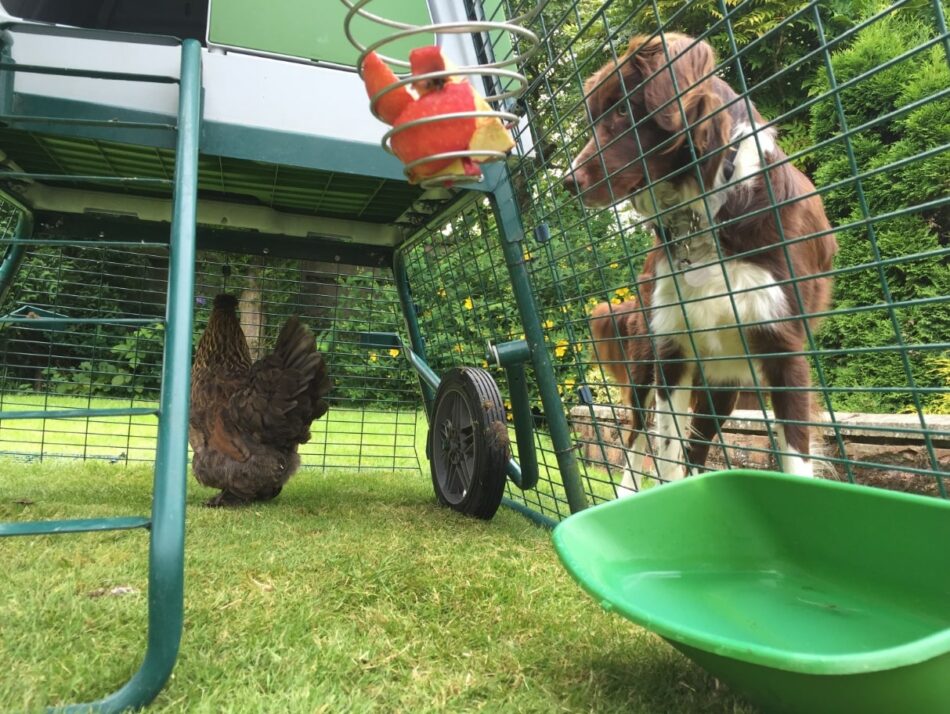

This entry was posted in Budgies

This article is a part of our Pride of Omlet series, a collection of amazing stories which shine the spotlight on extraordinary pets and share their selflessness, bravery, talent and compassion with the world.
-Written by Anneliese Paul
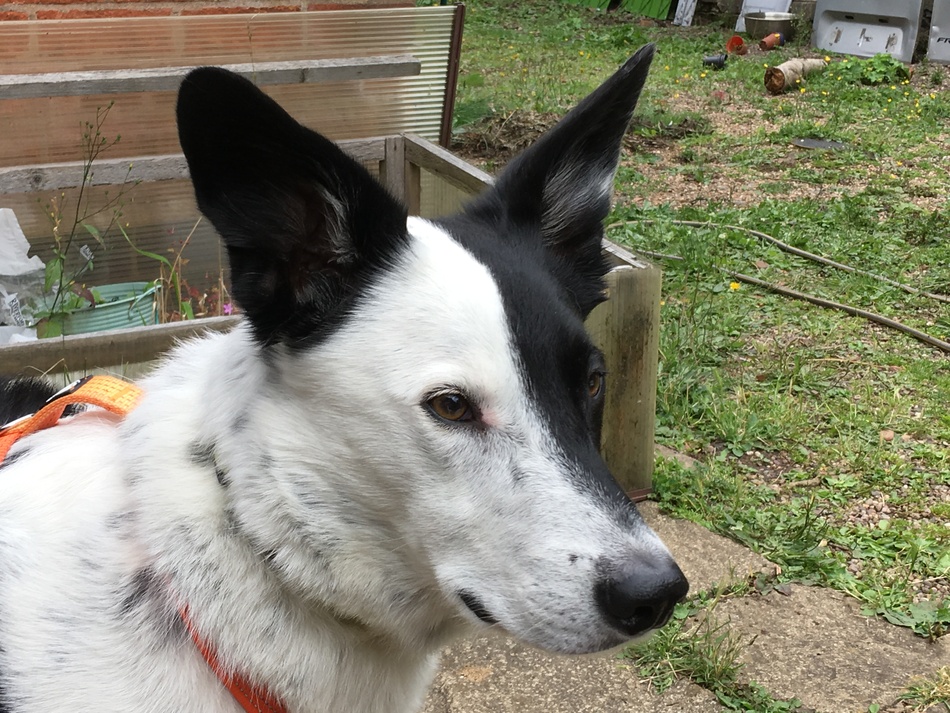
On paper, Kipper wasn’t exactly what Angela wanted. After years of behavioral challenges, he’s become the best-behaved blood donor and saved over forty dog’s lives. Kipper’s turned out to be Angela’s perfect match.
When Angela’s house was robbed, the first thing the police said was, “Get a dog.” Because a dog barks, and people are less likely to enter your home uninvited. However, working as a teacher, Angela felt she couldn’t look after a dog, especially not an active breed like a collie.
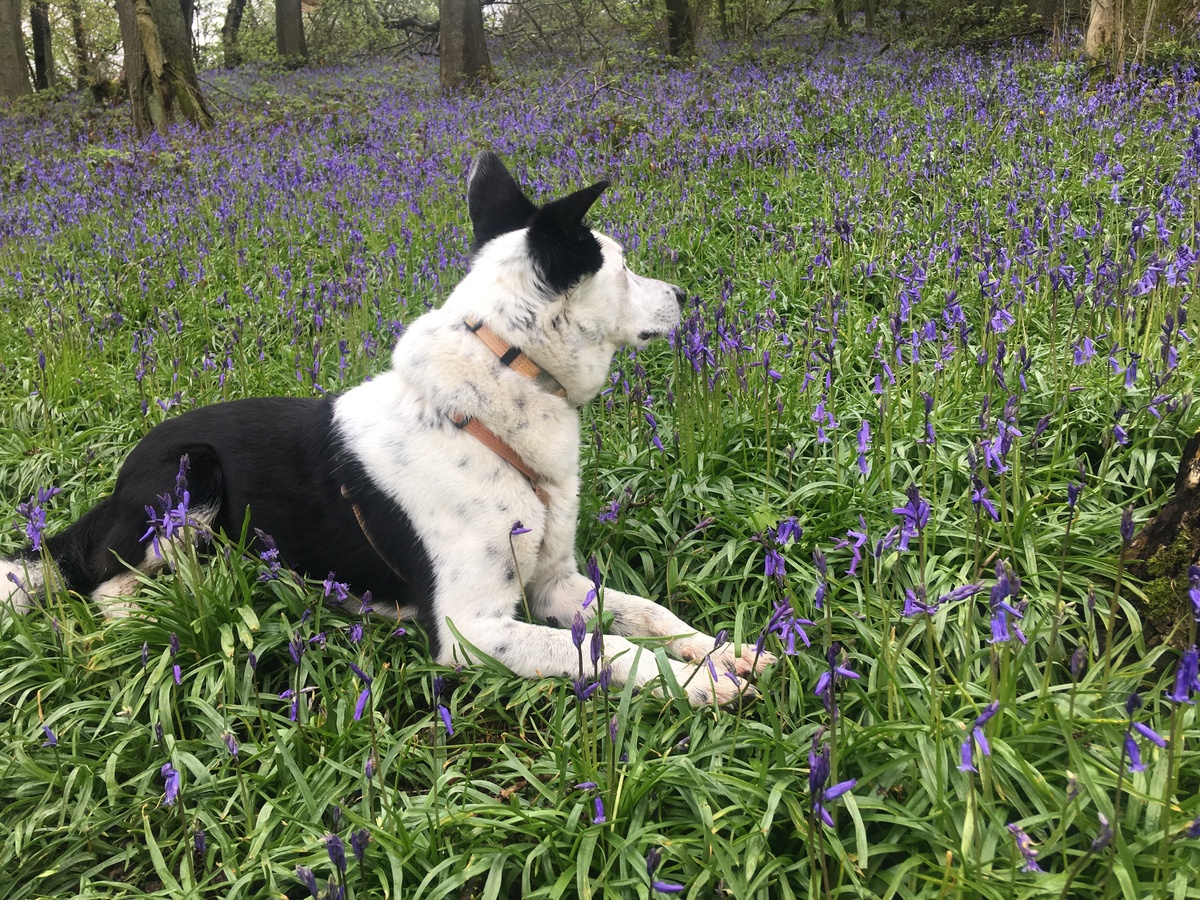
With fond memories of the collie she grew up with, she spent a long time talking to the Border Collie Trust, and they helped her find Kipper. He was an eighteen-month-old Irish stray and had been rehoused multiple times. Being a collie, Kipper had a lot of energy. On paper, he didn’t look right for Angela.
But the Border Collie Trust thought he was the perfect match and persuaded her to meet him. So, she went to the rescue center to get to know him. Angela could tell he was fantastic with humans, which was really important. So she took him for a walk and fell in love with him. A few weeks later, she brought him home to start their new adventure.
Angela had prepared a lovely kennel and run in the backyard for Kipper to spend half the day in. The plan was at lunchtime; he would be walked by a professional dog walker and then left in the house in the afternoon until she got home from school.
Kipper turned out to be hard work, boisterous and disruptive. He destroyed the house and was what Angela describes as ‘over the top’. In the evening, after a long day at work, Angela would go to tie up her shoes for a walk, and he would bite her hair, not in an aggressive way, just incredibly overexcited. It used to take them twenty minutes just to get to the front gate. It was exhausting.
But Angela had experience with Border Collies, she knew he had incredible intelligence, and he just needed things to keep him busy. Her teaching instincts kicked in, and with support from the Border Collie Trust, she began what would turn out to be life-changing behavior training for both her and Kipper.
At first, it was simply stopping and waiting for him to calm down whenever he did something that was ‘over the top’. Then Angela needed to tackle the chewing at home. She started by leaving him for five minutes, going to the front gate, standing across the road, then coming back in and praising him for being good. Angela worked out Kipper’s motivations (toys and food) so that she could effectively train him.
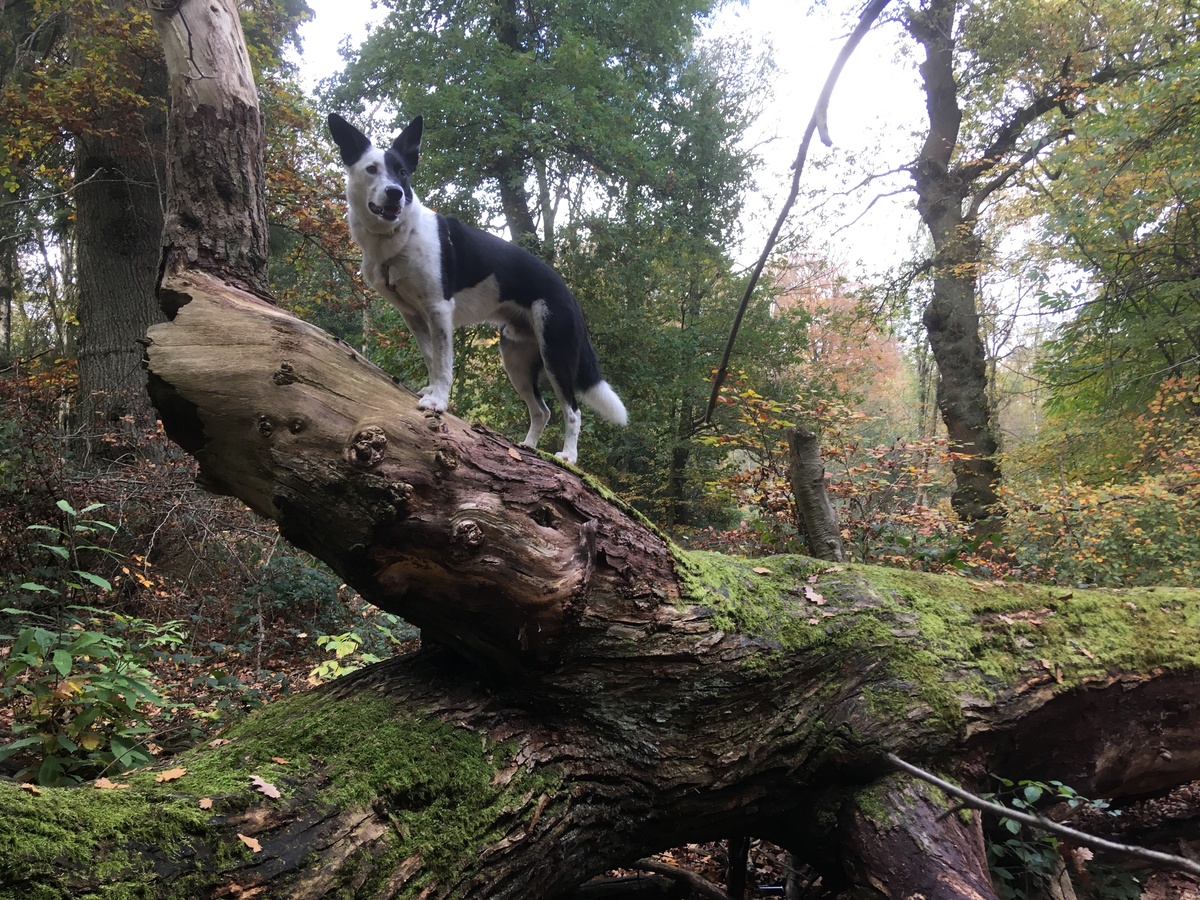
“He is so clever,” says Angela “, That he will work out. What am I being asked to do? What is the reward on offer, and is it worth it? And if it isn’t worth it, he won’t do it.”
Over time he made progress, and his behavior slowly improved. Angela worked hard with him, and as his obedience improved, their bond grew, so did the trust between them.
Kipper lives on the edge of the countryside and occasionally chases livestock, so he has to wear a muzzle on long walks. But incredibly, Angela can leave him alone, unmuzzled with the chickens in her backyard. His behavior at home has transformed so dramatically that Angela is confident Kipper will do whatever she asks him to. Angela has even watched a big bolshy chicken trying to steal Kipper’s bone!
“The chicken was getting closer and closer and closer, trying to peck at his bone. All Kipper did was pick up the bone and walk away.”
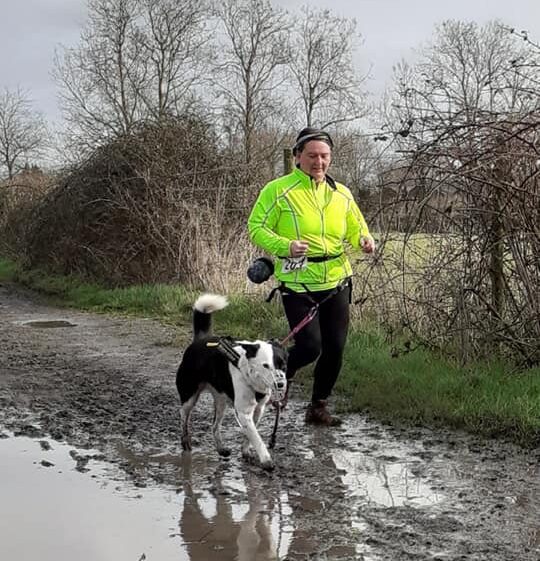
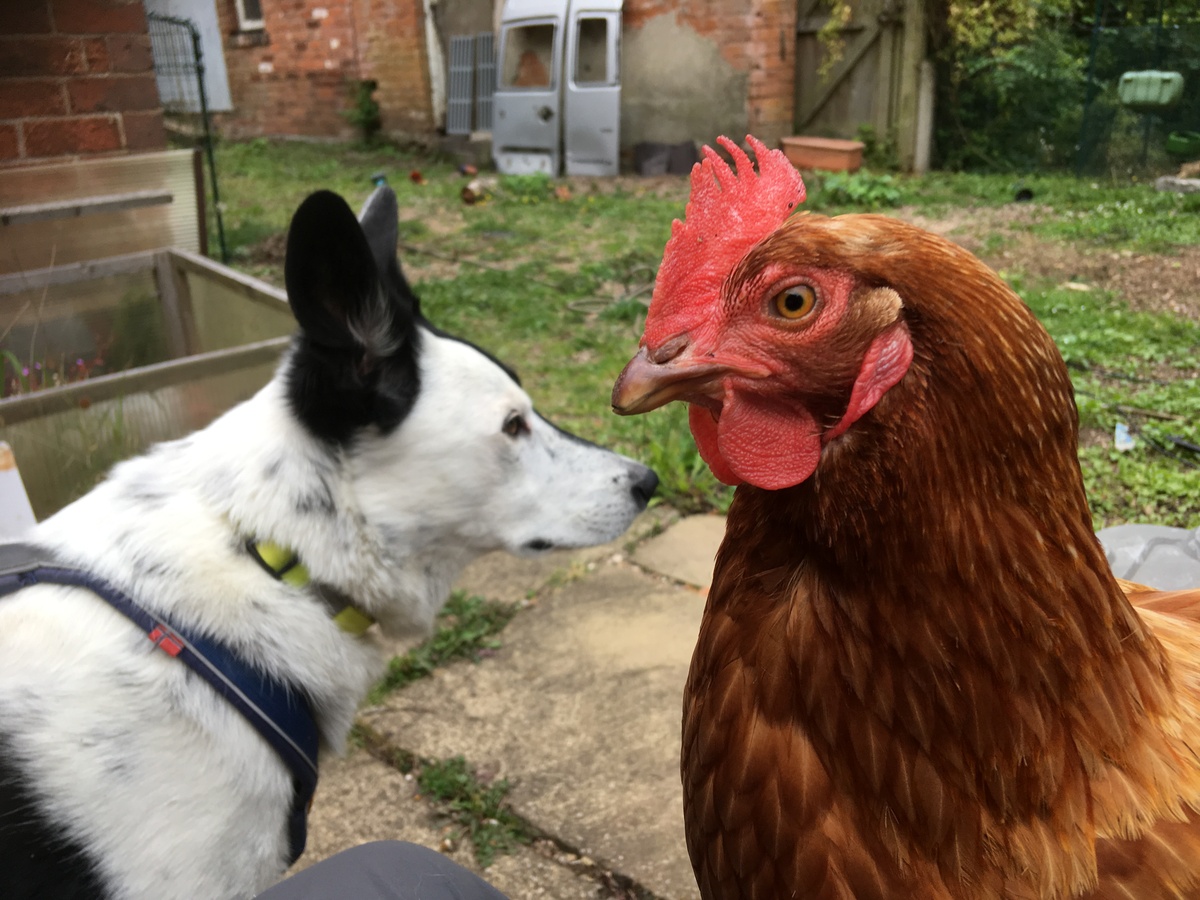
With good obedience at home, they started to have fun together. Kipper achieved Gold in the Kennel Club Good Citizen Dog Scheme and got to the Kennel Club Starters Cup Final in 2017, an agility competition for beginners. The activity and the mental work was fantastic for him, and they both made new friends, travelled to new places and shared memorable experiences.
But when Kipper had to have his dew claws removed, he couldn’t do his agility work, and the lack of exercise led to frustration. Angela, always on the lookout for ways to develop Kipper’s potential, discovered CaniCross. Cani sports are a whole range of sports to nurture the bond between dogs and their owners and are particularly beneficial for dogs with behavioral issues.
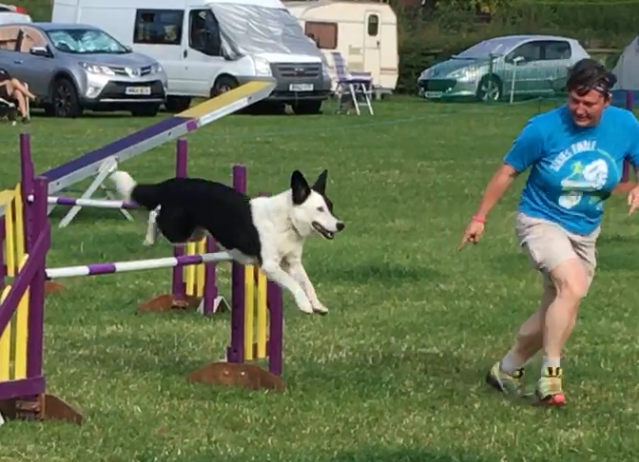
Taking part in cross country runs and triathlons, Angela and Kipper were getting fit together and making strong friendships with a whole community of like-minded dog lovers.
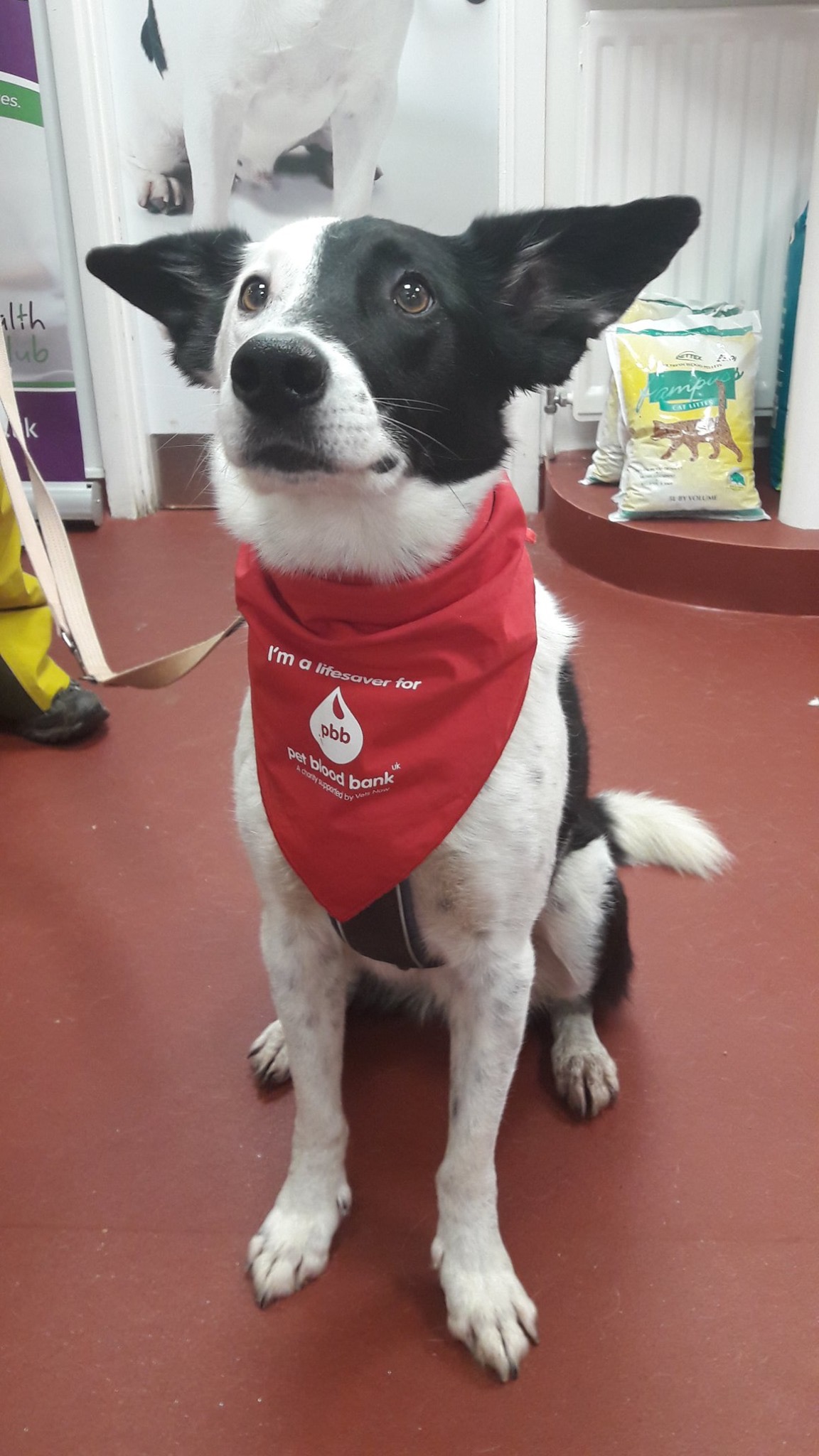
One of their friends introduced them to the pet blood bank. Angela was keen to give back to the dog community, but he was under the 25kg minimum weight. However, as he matured, his muscle development changed. As soon as he’d gained enough weight, Angela registered Kipper as a donor and proudly took him along to his first session.
But Kipper was terrified. He had to have a little piece of fur shaved and couldn’t stand the sound of the clippers. Once again, Angela turned to training. The blood bank advised using an electric toothbrush to get him used to the vibrating sound. Over time, using his favorite soft cheese as a treat to reward good behavior, Angela gently got him used to the sound until she was sure he knew it wasn’t going to harm him.
Finally, Kipper was ready to give blood, perfectly behaved. He’s now on his tenth donation, and with a rare negative blood type, his blood is a perfect match for any dog. With every donation providing blood for up to four other dogs survival, Kipper has helped save forty dog’s lives.
Kipper and Angela have experienced so much together. Pushing each other to do better, they’re a winning team. Motivating each other to get on with life and do something good, to make friends together. As Angela says,
“Not every dog would suit me, and not every owner would suit him, but the Border Collie Trust got it right. We were meant to be.”

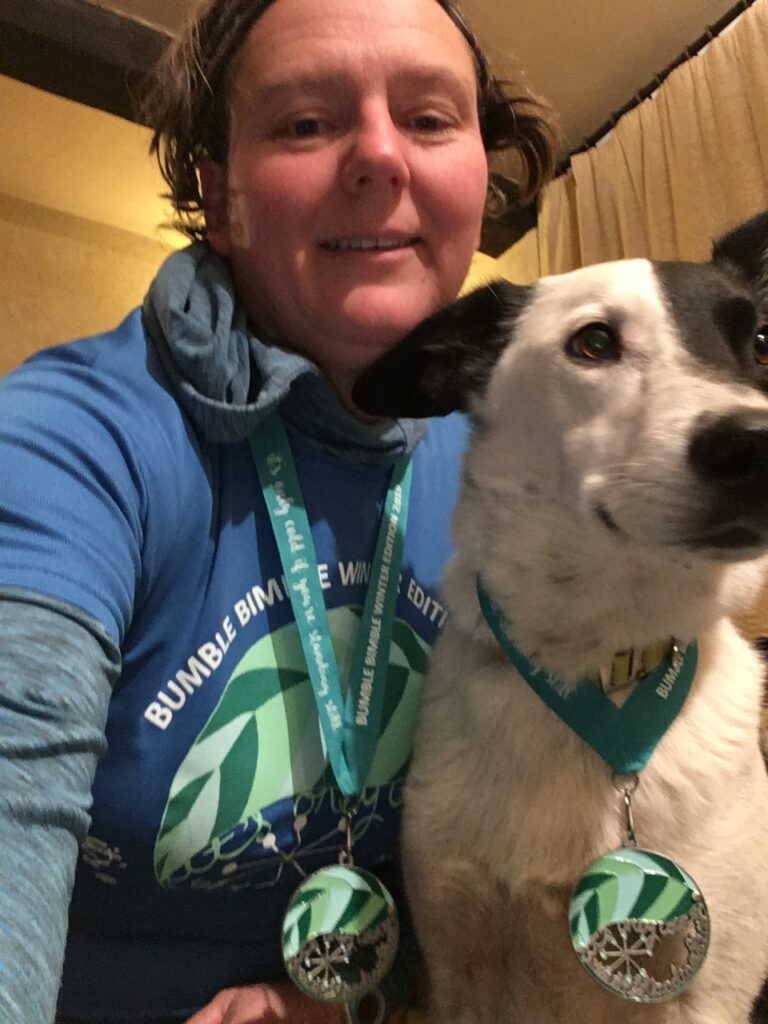
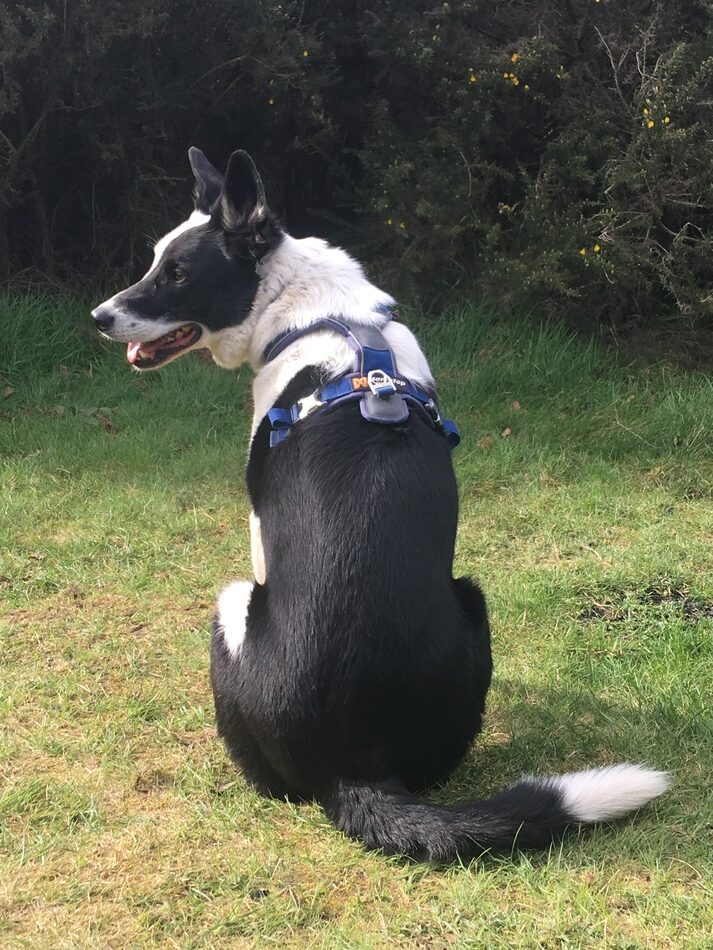
This entry was posted in Dogs
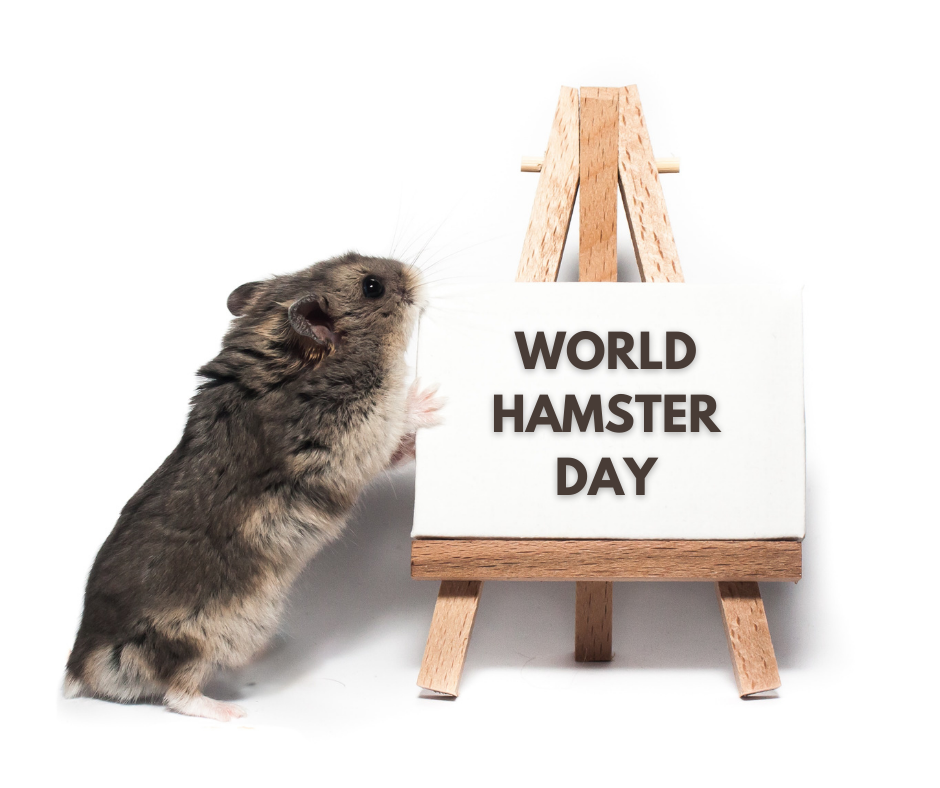 With World Hamster Day upon us on April 12th, what better time to celebrate these furry favorites? There are many reasons why so many people decide to get a hamster. Here are 10 of them:
With World Hamster Day upon us on April 12th, what better time to celebrate these furry favorites? There are many reasons why so many people decide to get a hamster. Here are 10 of them:
1. Hamsters are friendly!

Golden hamsters, once they have been successfully hand-tamed, form strong bonds with their owners. Although they don’t enjoy the company of other hamsters, they rely on their owners for company and interaction. Chinese hamsters can become very fond of their owners too, although they can also thrive in groups (unlike the Golden). The relatively large size of the Golden hamster makes it easier to handle than the smaller breeds, too.
2. Hamsters are easy to look after
A pet hamster pretty much looks after itself during its nocturnal adventures, and in terms of equipment, all it needs is a suitable cage with a few toys.
3. Feeding hamsters is not expensive
Although a hamster stuffs all the food you give it into its cheek pouches, this doesn’t Photo by Lucas Pezeta from Pexels mean they’re greedy!

The hamster simply hoards the food in its favorite corner and doesn’t actually eat very much on any given day. Your bag of dried food will last several weeks, especially when supplemented with a few slices of fresh fruit and veggies.
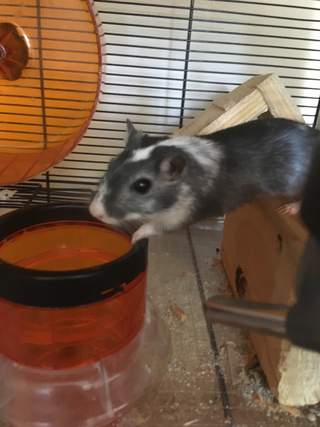
4. Hamsters are healthy!
These little rodents are generally healthy during their short lives, as long as they are kept in a suitable cage and fed a nutritious diet. The biggest hazard they face is sustaining injuries through falling, so they need to be handled with care.
5. Hamsters love to Explore
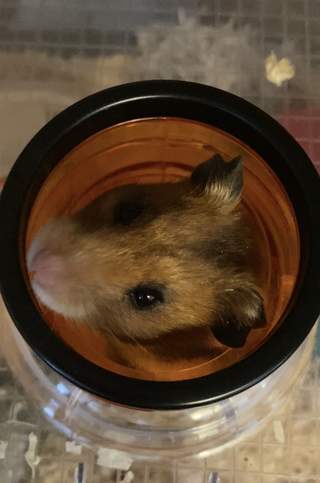
Endlessly inquisitive, hamsters love getting out and about in a hamster ball. If you can set up a secure enclosure, they will love exploring its every nook and cranny. Leave some treats hidden in the enclosure or stuffed into wicker balls, and the hamster will have a great time tracking them down and rooting them out. They also love playing on ladders or in runs.
6. Hamsters Don’t Need Intensive Training!
Hand-taming a hamster is the beginning and end of the necessary training. There’s no pressure to teach obedience tricks or toilet training, making them a very low-maintenance pet.
7. Hamsters Don’t Take Up Much Space
These are small mammals, making them suitable even for small flats.
8. Hamsters Are Very Clean
Unlike most rodents, hamsters choose one spot in their cage for the toilet, making them very easy to clean out. They are also scrupulously clean themselves, forever fussing with their fur. This means their human friends don’t have to do any of the pet washing.
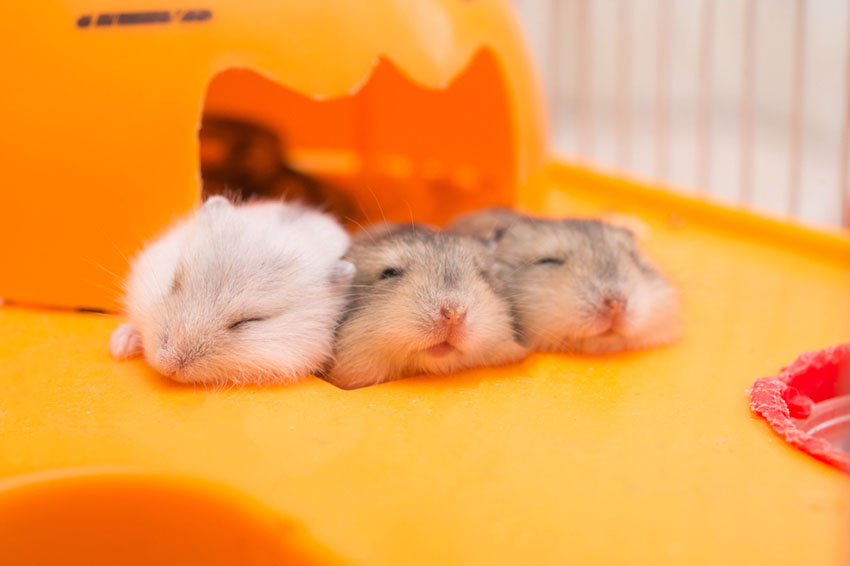
9. Hamsters are Calming
Nothing seems to ruffle a hamster. No woofing, no running away in a panic. They scurry around content and are the most relaxing things to watch outside of a peaceful fish tank!
10. Hamsters Don’t Shed Fur
Many people with allergies say that hamsters cause them no problems. This is linked to the fact that they don’t send tiny bits of fur drifting through the air or sticking to carpets. A hamster is nothing to be sneezed at!
12 April – World Hamster Day
On 12 April, hamster owners all over the world celebrate their furry friends. They are one of the most popular pets in the world, and yet they have only been kept as pets for the last 90 years or so.
The story of pet hamsters begins on 12 April 1930, when Israel Aharoni, a zoologist and professor at the Hebrew University of Jerusalem, captured a female Golden (or Syrian) hamster and her litter in Aleppo, Syria. Little did he know that this female would be the source of ALL pet Golden hamsters!
The hamsters were kept as laboratory animals, but escapees became the source of most of the wild Syrian hamsters in Israel today. Descendants of Aharoni’s captive hamsters were shipped to Britain in 1931, and the Zoological Society of London acquired a pair in 1932.
This pioneering pair were the Adam and Eve of British hamsters – in 1937, descendants of these pioneering rodents were given to private breeders, and these were the source of all the Golden hamsters in the British pet trade. If you own one, it’s 99,9% certain that its ancestry goes back to those London Zoo hamsters.
Mitochondrial DNA studies have confirmed that all domestic golden hamsters in the UK and the USA are descended from a single animal – the one captured in 1930 by Israel Aharoni.
That international brotherhood and sisterhood of hamsters is certainly something worth celebrating!
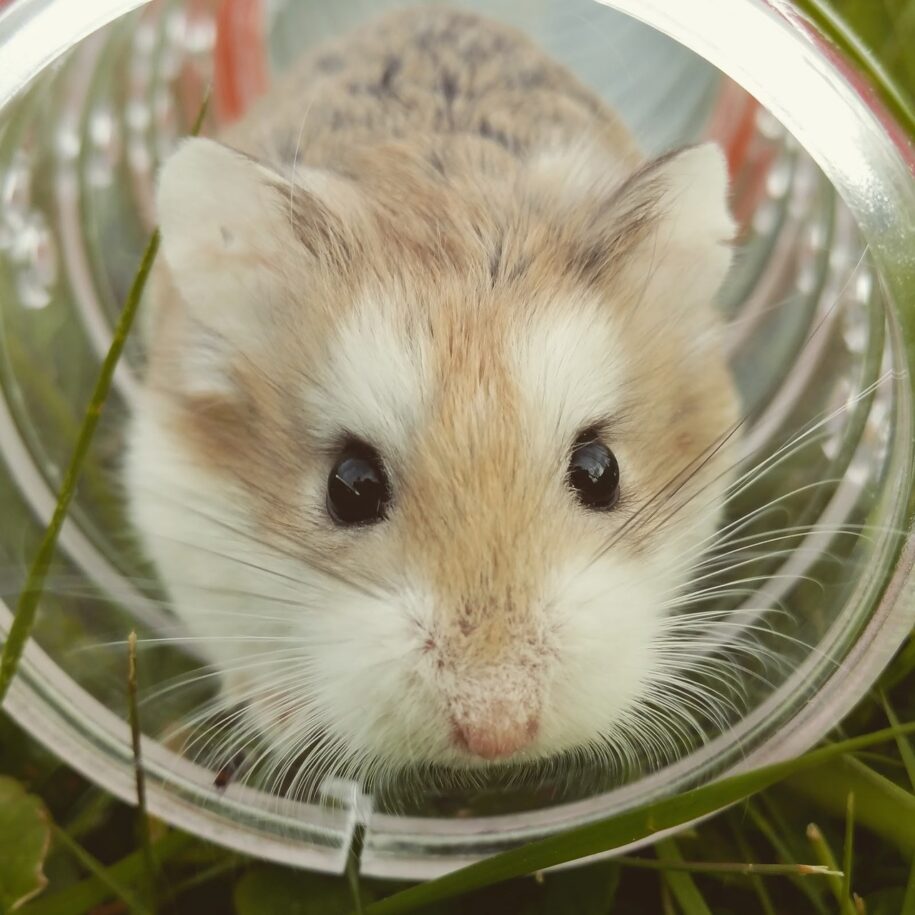 Photo by Silje Roseneng on Unsplash
Photo by Silje Roseneng on Unsplash
This entry was posted in Hamsters
Cockerels have three main purposes in a flock of chickens. They protect the hens by warning of any danger, they enable you to breed your own chicks, and they look fabulous. Sometimes, however, the cockerel’s protective instincts becomes a problem, and the bird becomes over-aggressive. This can be a particular issue in the spring, which is the breeding season.
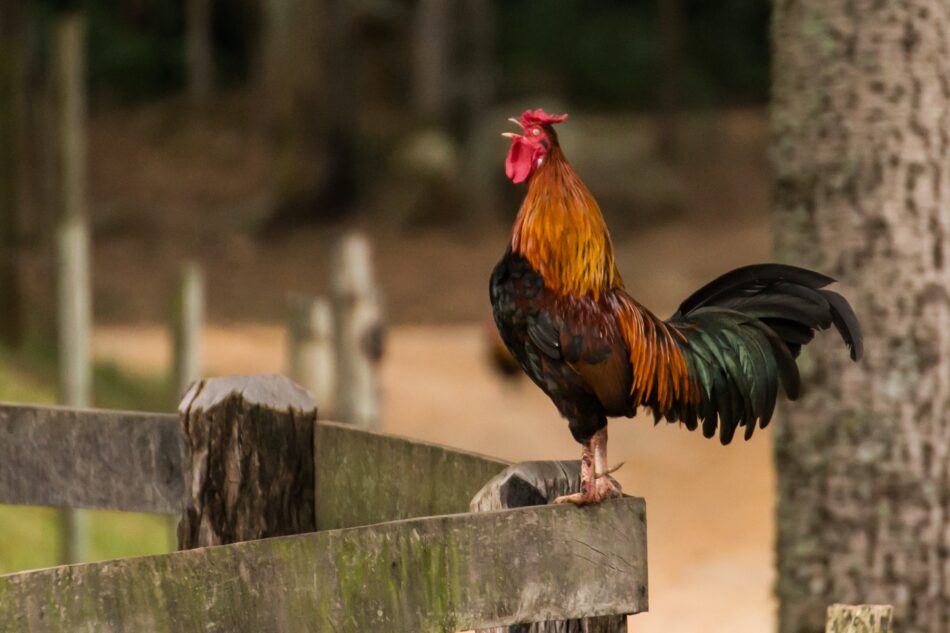
Cockerels are wired to protect their hens. If you watch the flock foraging in a garden, the loud clucking of a hen will bring the cockerel running to make sure everything’s okay. If a hen squawks when you pick her up, the cockerel will put on an aggressive display until you put her down again. As long as this doesn’t involve physical attacks, there’s no problem. Some cockerels will physically attack, though.
If these face-offs continue, the cockerel might decide that you – and all humans – represent danger and will try to fight you off at all times. Luckily, you can usually defuse the situation.
Cockerels give warning of their intention to attack. They lower their heads and perform a strutting dance while looking straight at you. Things get trickier if the cockerel decides to run up and attack your legs, like an angry farmyard goose. If you’re walking away, the cockerel may chase you from the yard, and that can cause nasty surprises too.
How Do You Stop a Rooster From Attacking You?
- Don’t walk straight towards the cockerel when you enter the place where the chickens are kept.
- Don’t stare at the cockerel unless he’s already behaving aggressively, as this is a sign of aggression as far as he’s concerned – you’re fixing your eyes on him and his flock just like a predator would.
- Don’t tiptoe around or run away if the cockerel looks at you, as these are signs that you’re afraid, and the cockerel might take this as a cue to rush in and finish the job!
- Don’t dash around the yard – the cockerel equates quick movements with predators. Go about your business in the chicken yard in a calm, slow but focused way.
- Make sure your hens are in a stress-free environment. If there are prowling dogs or unruly children running amongst the hens, their clucks and squawks will send the rooster into overdrive to protect his girls.
- If your cockerel brings you small ‘gifts’ such as stones or twigs, don’t be too flattered. He is treating you like a hen, and you will have to refuse the gifts and shoo him away, otherwise he will think he’s subdued you with his presents!
- Don’t crowd the cockerel. If he feels trapped in a corner, he is likely to fight his way out.
How to Handle an Aggressive Cockerel
Never respond to an angry cockerel with violence.
This will have no positive effect on the cockerel or flock’s behaviour afterwards, and it can result in serious injury to the bird. He may be aggressive, but a cockerel is still a bird, fragile bones and all.
A cockerel should be lifted with thick protective gloves to remove him to a safe place or away from the eye of the storm. Your arms and legs shouldn’t be bare when handling the rooster, and your footwear should be sturdy too. If the cockerel is only in the early stages of aggression, he can often be calmed down with a few treats. It is a good idea to carry treats with you whenever you’re in the same place as the cockerel. After you’ve fed him a few times, he will come to associate you with treats rather than danger. The treats should be hand-offered. If you throw them down and then run away, the rooster will recognise that you’re afraid, and the problems might continue.
A more hands-on – or feet-on – method is to gently roll the cockerel over with your safely booted foot when he approaches you looking for trouble. After a few of these gentle wrestling throws, the cockerel will realise that you’re the top bird in the run and give you no more trouble. In theory, at least!
How to Lift an Angry Cockerel
Alternatively, when the cockerel tries to peck you, scoop him up with your gloved hands and hold him like you would hold a hen, under your arm. The cockerel will flap and squawk angrily, but he will eventually calm down if you ignore these protestations. This may take 10 to 15 minutes, but it’s time well spent if it means that the cockerel will not attempt to attack you again.
If the cockerel has not yet attacked, you may be able to deter him by taking a large, deliberate step towards him, looking at him as you do so. If the rooster starts to fidget and looks at the ground or starts pecking it, you have won the battle, and you can back down without fear of attack.
The key to all these methods is to make the cockerel realize that you’re not a threat to his hens. Protecting the flock is all he wants to do. If that doesn’t work, and if the cockerel starts to stretch his wings and neck ready for attack, stretch out your arms. Carrying a stick can help here, as it makes your ‘wingspan’ look even greater in the rooster’s eyes.
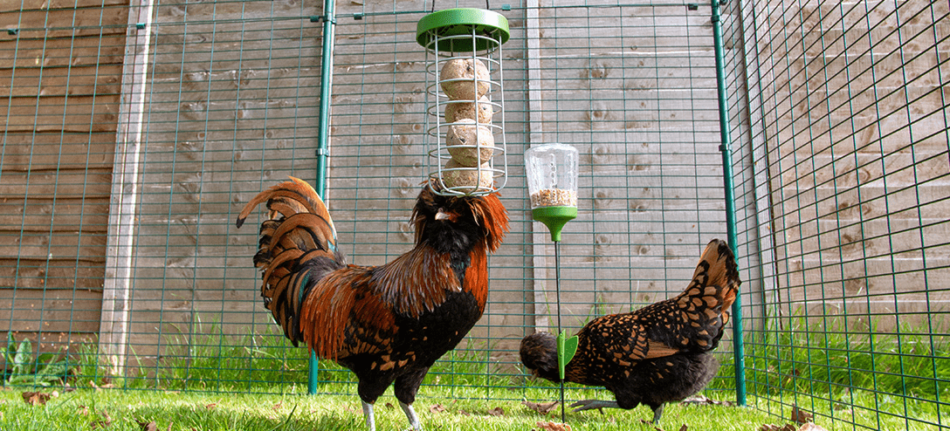
Treat holders and peck toys will keep your chickens entertained for hours!
What is the Most Aggressive Rooster?
Circumstantial evidence suggests that some cockerels are just born mean! In these cases, the cockerel’s instinct to protect a flock of hens is in constant overdrive. The aggression is occasionally seen when the birds are still chicks, although it is more usual for the aggression to kick in at 6 to 8 months old. Although the breed of the chicken makes a certain amount of difference, even supposedly gentle breeds can sometimes decide to take no prisoners in the chicken yard!
The most aggressive rooster breeds are said to be Aseel (allegedly the biggest bullies of all), Cornish, Leghorn, Malay, Old English Game and all other traditional ‘cockfighting’ or ‘game’ species.
What is the Least Aggressive Rooster?
The least aggressive roosters include the Australorp, Brahma, Polish, Silkie and Welsummer. Bantam breeds tend to be relatively calm, too. However, there are occasional ‘bad apples’ in all breeds, and some cockerels just seem to hit an aggressive streak and never entirely leave it behind.
Constantly aggressive roosters are a real problem, especially if you have children wandering in the garden or backyard. A cockerel readily backs up his anger with a physical attack, and he is armed with sharp spurs – the spikes on his legs – that can do real damage. If all attempts to calm the cockerel down fail, the tyrant rooster will have to be rehoused.
If you have chosen a non-aggressive breed of cockerel, and if your chickens have lots of space, you will seldom have major problems with rooster aggression. Let cockerels know whose boss as soon as they hit adulthood, never accept those tempting little gifts, and you should be recognized by all your chickens as being top of the pecking order.
This entry was posted in Chickens
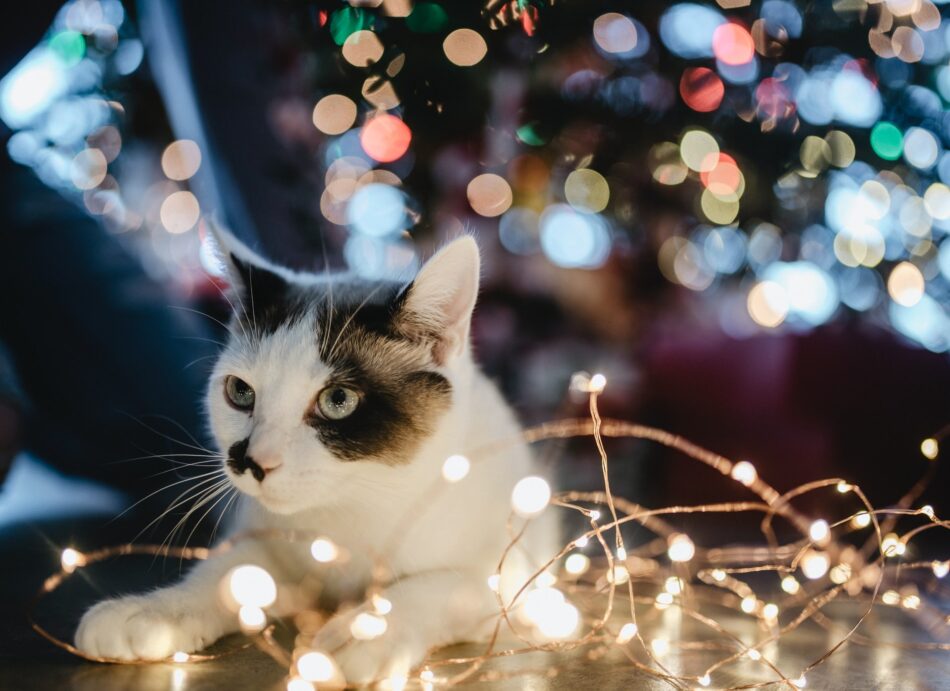 Photo by Jasmin Schuler on Unsplash
Photo by Jasmin Schuler on Unsplash
Holiday Animal Quiz: Can you Identify the roles of these animals in these holiday movie favorites?
1.What does the Grinch tie to Max’s head in the movie?
A. A twig
B. Holly
C. A bell
D. Mistletoe
2.What does the Grinch steal from a mouse when he is stealing from the Who’s in Whoville?
A. A piece of cheese
B. A cookie
C. A candy cane
D. A crumb
3. Who provides the voice of Rebecca the Hen in the 2017 holiday movie “The Star”?
A. Mariah Carey
B. Keegan Michael Key
C. Aidy Bryant
D. Gina Rodriguez
4. In “A Charlie Brown Christmas”, why is Snoopy decorating his dog house?
A. For Charlie Brown
B. For a holiday contest
C. For Santa
D. For Woodstock
5. In the movie “Annie”, what is the name of her beloved Dog?
A. Goldie
B. Molasses
C. Sandy
D. Butterscotch
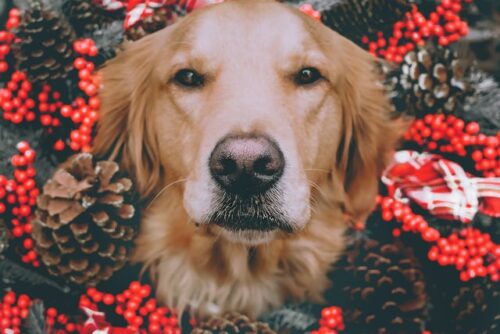
6. In the movie “The Holiday” what is the name of Kate Winslet’s Dog?
A. Charlie
B. Chip
C. Jackson
D. Pip
7. What animal says the line “Bye Buddy, I hope you find your dad!” in the movie “Elf”?
A. A whale
B. A seal
C. A narwhal
D. A polar bear
8. What is the name of Snoopy’s bird sidekick in “A Charlie Brown Christmas?”
A. Tweetie
B. Sunny
C. Pebbles
D. Woodstock
9. What is the name of the famous red-nosed reindeer?
A. Rudolph
B. Prancer
C. Dancer
D. Comet
10. How does Rudolph help Santa on Christmas Eve?
A. His nose helps detect rain or snow
B. His nose detects which houses are on the naughty or nice list
C. He flashes his nose to the airplanes to make way for Santa
D. He guides his sleigh
Answers: 1.A, 2. D, 3. A, 4. B, 5. C, 6. A, 7. C, 8. D, 9. A, 10. D
This entry was posted in Christmas

2020 has certainly been an unusual year for most of us so far. Here at Omlet we’ve been working from home since the end of March, and many of us have spent more time than normal with our chickens, dogs, cats and other pets. To get an idea of how pet ownership has affected lockdown, we decided to ask our followers how their pets had helped them cope with these strange times. Here is a summary of the results:
88% of people agreed that staying at home has been easier with a pet! It’s no news that pets are great emotional support during difficult times, and apart from that they keep you busy. If you keep chickens you have to go out in the garden a few times a day to refill food and water or check on your girls, and if you have a dog they must be walked. Having routines is a great way of keeping structure when things are uncertain, and will benefit both physical and mental health, so it’s no wonder that 88% of people are thankful for having a pet throughout lockdown!

Nearly 2 out of 3 people thought that their pets had enjoyed seeing more of their owners, which shows how little they actually require from us. It doesn’t have to be long hikes or elaborate playtime setups, just having you around is enough for most pets. Only 0.5% said that their pets seemed annoyed or tired by the additional human interaction – can we guess that these people own independent cats by any chance?
1 in 4 people said they spent more time teaching their pets tricks during lockdown.
Many of us have been working from home and tried to master all the challenges that come with setting up a home office. For people with pets this challenge might have been even bigger. Whether by squeaking guinea pigs, clucking hens or barking dogs, 75% of people said that they had been easily distracted from work by their furry or feathery friend. 50% had also had a video called interrupted by their pet.
76% of everyone who took the survey said they would like to work from home more often in the future so they can spend more time with their pets. As we have already established, our pets have also seemed happy to have us at home more, so it’s certainly a setup that would benefit both pets and owners.
Not as many people would like to bring their pets into work with them; only a third said they’d like to let their pet meet their colleagues. We’re guessing this might have to do partly with what animals people have got, and how convenient it would be to take them to work. Sure, we’ve heard of office dogs, but is an office chicken taking things a bit too far?
Out of the people who would like to take their pet to work with them in the future, nearly two thirds believed that their boss would not allow it. If you reckon your boss would say no, let them know that studies done with office dogs show that having a four legged friend running between the desks proved to boost morale, increase job satisfaction and reduce stress within companies and organisations.

Terms and conditions
Promotion of $10 off when you spend $100 is available until midnight 08/08/2020. Use promo code THANKYOU at checkout. Total basket value excluding delivery must be $100 or more. Subject to availability. Omlet ltd. reserves the right to withdraw the offer at any point. Offer cannot be used on shipping, existing discounts or in conjunction with any other offer.
This entry was posted in Pets
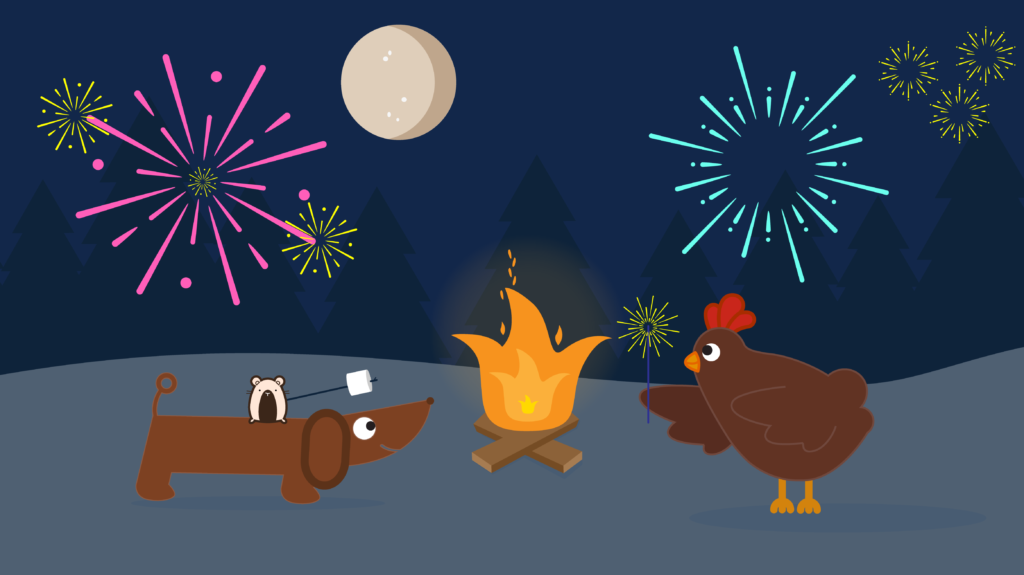
Some pets hardly seem to notice fireworks. Others hide quietly until it’s all over. But some are genuinely traumatised by the noisy, flashing skies of Independence Day.
For a pet who’s afraid of the bangs, whizzes and flashes, the fireworks season is bad news. There are, however, a few things you can do to minimise the stress.
The Big Bang
When talking about pets hating fireworks, we’re usually talking about dogs. Some dog charities estimates that 45% of dogs are afraid of fireworks to some degree.
Cats will find a quiet space away from all the fuss (although some individuals certainly get stressed by all the noise). Keep your cats indoors when the fireworks are going on. They can quickly panic if fireworks go off suddenly nearby, or if sparkler-waving children come running down the street.
Small animals such as gerbils, hamsters and guinea pigs will either ignore the explosions or sit it out in their hidey holes.
Most caged birds don’t enjoy the sudden rupturing of the night skies – they like their nights to be dark and their days to be light, not a crazy mixture of the two. If your parakeet, parrot, canary or pet finch is in a room affected by the flashing lights, you might want to cover the cage. But some birds don’t seem to ruffle a feather, in spite of the fireworks.
What you should never do is allow the pets to be trapped in their outdoor runs or aviaries with no bolt hole. As long as outdoor pets have a covered area to escape to, they should be fine.
Dogs Hate Fireworks
If your dog isn’t too fazed by the noise and lights, simply keep him indoors while the party rages outside. For more skittish dogs, there are a few extra precautions to take.
- Stay indoors with the curtains and windows closed. A scared dog caught outside is very likely to run away.
- Use a crate or other safe space. If there’s somewhere the dog associates with safety – a Fido Crate, perhaps, or a quiet room with a dog bed – make use of it. If there’s a room facing away from the main area of firework activity, put the dog in there. A bathroom often works well for this purpose. Gentle music can help keep out the noise too. Put familiar objects in the safe room – the dog’s bed and blanket, and some favourite toys. And stay with him, unless he’s happy to curl up and sleep through the storm.
- For very nervous dogs, vets recommend a wrap or dog vest, tight enough to apply gentle, constant pressure. This soothes and calms your poor pet.
- Stay calm yourself, and stay with your dog. That will help enormously.
- Don’t be tempted to let your dog go outside for any reason, and make sure he’s had his walk before the celebrations begin. Even a dog who takes it all in his stride indoors might suddenly panic outdoors when the fireworks start to fizz.
Prepare In Advance
You can desensitise dogs to the sound of fireworks to a certain extent, by getting them used to loud noises. The best way to do this is to play thunderstorm or fireworks sounds at a low volume, giving the dog treats and lots of fuss and play in the meantime. If you then increase the volume while keeping up the treats and play, it will, in most cases, make your dog associate the noise with good times.
This doesn’t work with all dogs, but it’s definitely worth a try if you want to have a stress-free 4th July. There’s not long to go, so better start now!
This entry was posted in Pets
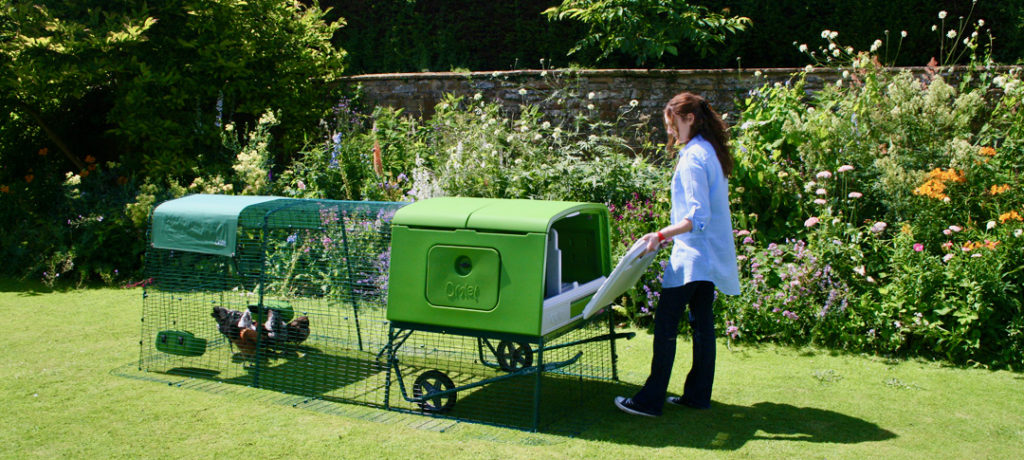
If you own and love an Omlet product and like talking to other people about your pets, then becoming an Omlet Ambassador will definitely suit you!
The Omlet Ambassador programme offers a really great way for people to not only see the products they are interested in, but also ask an owner all about it, like a live, interactive review!
If you speak to someone that then goes on to buy, you will get commission on their order. On top of that, Omlet customers in other countries have found lots of like minded friends through the Omlet Ambassador programme so it’s a great way to meet people who share your hobby in the area!
We spoke to two of our US ambassadors, Sueellen and Jennifer, about their experience of being an ambassador, and this is what they had to say:
Tell us about your chickens and your setup!
SE:
I am fortunate enough to have 2 different communities of very sweet chickens! We have 8 chickens right outside our side door and we have 23 chickens in our pasture in the backyard. We have had this arrangement for 3 years.
J:
The first is five barred rock layers. We have had them for about a year. They are in the Omlet Coop with a run and an outdoor enclosure. They get along well with each other, but won’t accept any new members. They are good sized birds but do fine in the space we have. We could increase the size of the flock no problem in the coop setup that we have.
We also have 1 white silkie, 1 blue “satin” silkie, and 2 silkie mixes (probably silkie/polish – the white one is a sizzle, the black one not sure). They are all hens except the satin. They lay but are really pets. We have had the polish/ silkies for about a year and the silkie for 6 months. The white silkie is a hen but thinks she is a rooster – his/her name is Juancho. She sings and talks all day long. Quite a character. The blue satin silkie is new to the flock. We have to be a bit more careful with them in cold weather and rain because they are so small, get wet easily and cannot fly. During the day we keep them with our Kune Kune boars Max and Luigi who help keep them safe and warm.
What do you like about your Omlet products?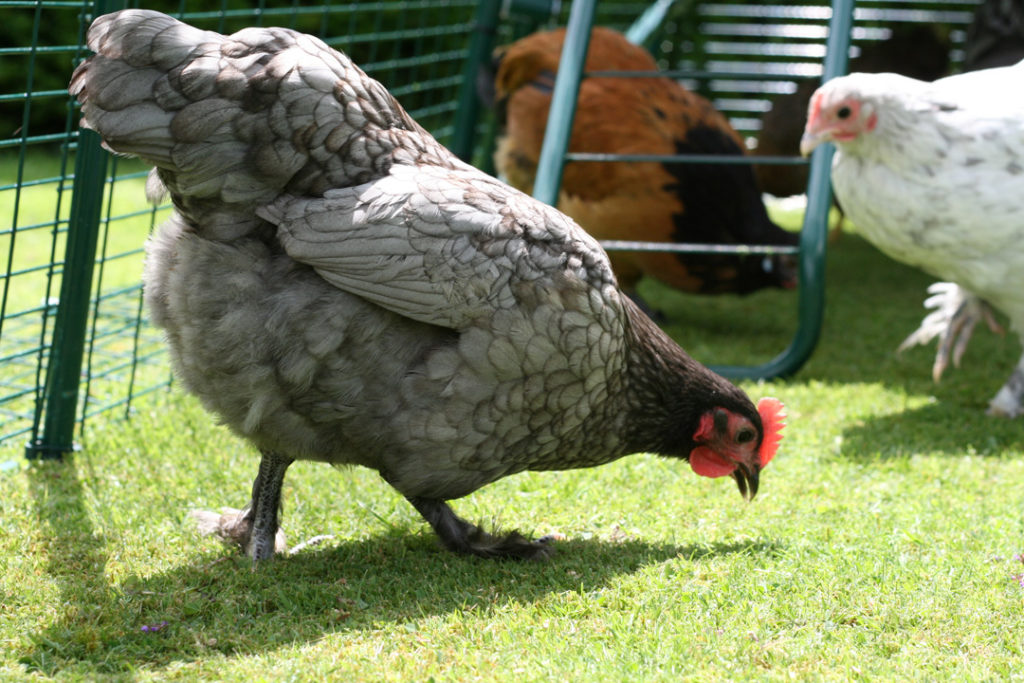
SE:
About 10 years ago we got our first chickens and the entire family (all 6 of us) loved having them. We loved their darling and hilarious personalities, and we loved getting the beautiful eggs as well. But over a short time we began to lose our chickens to many predators! It was heartbreaking to say the least! Fortunately, one of my daughters discovered the amazing Omlet products at a trade show. She told me about the Omlet coops and the pet runs and various other products! I fell in love immediately!
I love love love the way the Omlet products look. They are beautifully designed and are very easy to clean and maintain! 3 years later my coops look new! I love the pet runs especially, as they can be smaller or larger depending on your flock needs. I love that I can walk into the runs without bending down or getting on the ground. This feature enables me to easily feed, water, clean, visit and bond with my flock!
J:
We love the Omlet coop and enclosure. It’s very easy to keep clean and we have had (so far) almost no hygiene/sanitation issues. I believe that the plastic helps minimize this vs. wood or porous material. The coop is warm in the winter and stays cool in the summer even in our extreme heat. We have a lot of predators and so far, no one has been able to get in. They seem to have a hard time even getting on the coop because of the rounded roof so that is an extra plus. I also like that the product is simple – just three levers to use – simple. Everyone seems really happy and the barred rocks average an egg a day!
What’s your experience with being an Omlet ambassador?
SE:
I love being an Omlet Ambassador! I love all the products and the versatility they offer! I love my chickens! They are a sweet, hilarious and adorable part of our family. It is super fun to collect farm fresh healthy beautiful eggs everyday!
It was a very natural progression to become an Omlet Ambassador because I love the products, and I really enjoy sharing my experience, my knowledge and my love of chickens! I enjoy showing other chicken enthusiasts or others just curious about chickens our set-up!
J:
I decided to become an Omlet ambassador because I really believe in the product and my interactions with the company have been very positive – seems like a nice group of people out trying to sell a great product.
What does a normal visit or contact from a prospect look like?
SE:
Often a person considering getting chickens and/or a chicken coop will contact me by email with a few questions. We begin a dialogue and set up a visit for them to see the fabulous Omlet products at work! We choose a time convenient for both of us! Once people see the chickens and the Omlet Coops, they can’t wait to get started with their own amazing Omlet community!
J:
Pre virus, we had a few visits – everyone was very well informed (people really do their research!) and mainly wanted to see the product up close. I think part of it is the cost – it is expensive and therefore people want to make sure it’s the right thing before committing. Recently, we have had a lot of inquiries from people who are looking at getting chickens for the first time, probably driven to it by the high cost of eggs here in California. Some of them say they are a bit intimidated by the whole thing and again, want to make sure they are doing the right thing. We are definitely not chicken experts but the Omlet products help keep things simple – I am very confident that our ladies will be safe and clean, which seems to be half the battle!
If you think you would want to become an Omlet ambassador, send us an email and we will send you all the information you might need!
This entry was posted in Pets
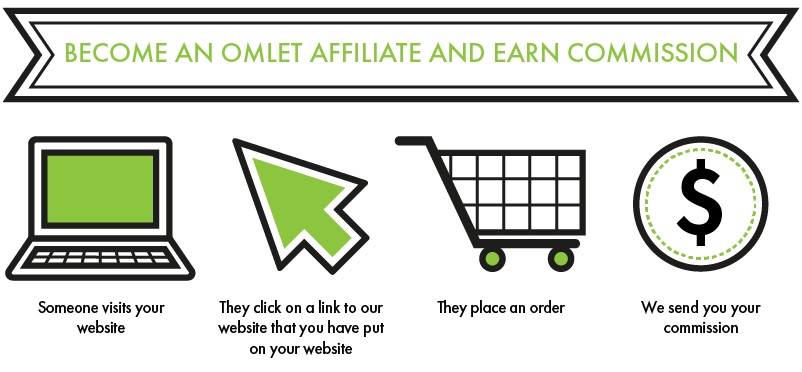
By becoming an Omlet affiliate you could earn 5% commission from every sale you generate from your website, blog or social media account.
You will put a personal link to our website somewhere on your platform. If someone clicks on the link and goes on to place an order, we will give you your commission!
What are the benefits of the Omlet Affiliate Programme?
- First and foremost, you can earn money from very little effort, and turn your website, blog or email marketing campaigns into an income.
- There are no start-up or running costs, you can start earning straight away.
- You can promote our products without having to carry any inventory, so there is no risk for you.
- All customer communications, shipping and returns are handled by Omlet and our in-house Customer Service Team.
- You can choose which products you advertise to your followers or customers, and how you would like to promote them. You can change links according to season or change a link for a banner whenever you like.
Why advertise Omlet products?
Omlet products are instantly recognisable and unlike anything else on the market in terms of design and quality. We actively work on and invest in brand and product awareness, so that when customers see Omlet products on your platform, it is likely that they have already heard of the brand.
We have a team of product designers who are constantly working on new products, so there will always be something exciting to show your customers or followers.
How do I get started?
Create an Omlet Account and log in here. Click on the ’Affiliate Programme’ button in the menu on the left hand side of the screen. You will then be able to enter the details for the website where you will post your affiliate links. This can also be a social media account!
Once that is set up an orange banner will appear at the top of the screen when you’re browsing the Omlet website. Visit the page that you would like to link to on your platform, for example the Autodoor page. Click on Link to this page, and the system will create a link and a piece of HTML that you can paste onto your website.
You can also download banners to put on your website. At the moment these are available for Chicken, Cat and Dog products.
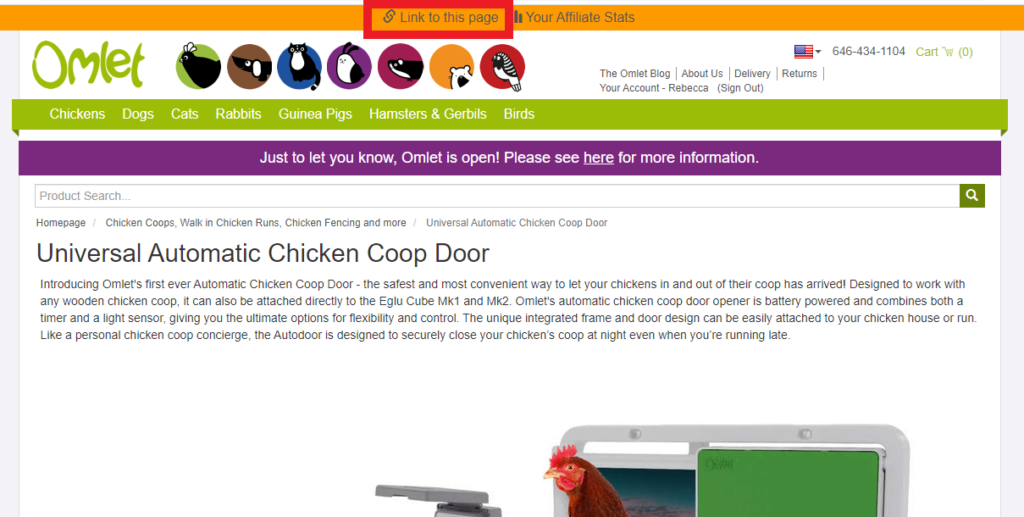
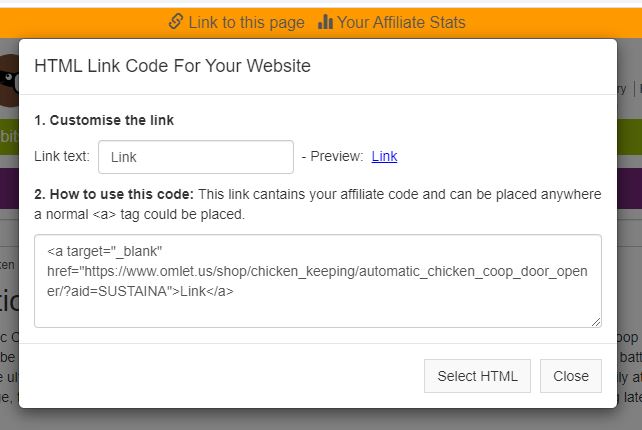
How do you know which orders come from me?
The link you create when you click on the orange banner is unique and it contains information about your website. When someone clicks this link from your site Omlet knows that the person has come from you. Even if they leave the Omlet website and come back again we still know that they originally came from you. This works for up to 60 days from the original click.
You will receive your affiliate commission on anything that the customer purchases on the Omlet website within that 60 day period. The customer doesn’t have to buy the product you are linking to for you to get commission, we will be able to keep track of your Affiliate ID as the customer moves around the website. This means that if they clicked a link about the Autodoor on your site and end up buying an Eglu Go Hutch you will still get your affiliate commission.
You can create as many links as you like to as many pages as you like.
The system will track link clicks, banner views, orders and commission and on your Omlet account you can see where your commissions are coming from and how many clicks different links are getting, which can help you find out what works best.
How do I get paid commission?
When you have earned commission you can request for it to be transferred into your PayPal or bank account. The commission will be paid out 30 days after an order has been dispatched to the referred customer (this is because customers can return a product up to 30 days after receiving it.) Please note that the commission of 5% is calculated on the order value excl. tax, and no commission will be paid on delivery costs.
Do I need a particular type of website to participate?
No, you can add any type of website, blog or social media account as long as it does not host content that is in any way unlawful, harmful, threatening, obscene, harassing, discriminatory, defamatory or otherwise objectionable; facilitates or promotes violence, terrorism, or any other criminal activity; is sexually explicit; or infringes or assists or encourages the infringement of any intellectual property rights belonging to any party.
This entry was posted in Pets
We have received many questions in the last few days regarding orders and delivery. We would like to reassure you that our distribution centres are fully open and all our office team are now working from home.
There was a sudden increase in demand for some products and there may be slightly longer delivery times than normal as a result. We have lots more products already on their way and you can pre order online now. Next to the buy button you will be shown an estimated dispatch date and it’s also shown in your basket.
We will email you again when the order is dispatched and you can always check in with our brilliant customer service team anytime to modify your order.
Please note that once your product has been dispatched you should use the shipping companies tracking services to keep up to date with your orders progress. We will always email you your tracking details. Deliveries are sometimes taking a little longer than normal as the couriers have to react to any changes to their ability to deliver. Please also note that you may receive your order in more than one delivery on two separate days.
The Omlet Team is here for you! We will still be running our usual promotions and competitions (check our social media channels and newsletter for latest) and we’ll be doing our best to keep you and your pets entertained throughout the next few weeks.
The Omlet Team
This entry was posted in Pets
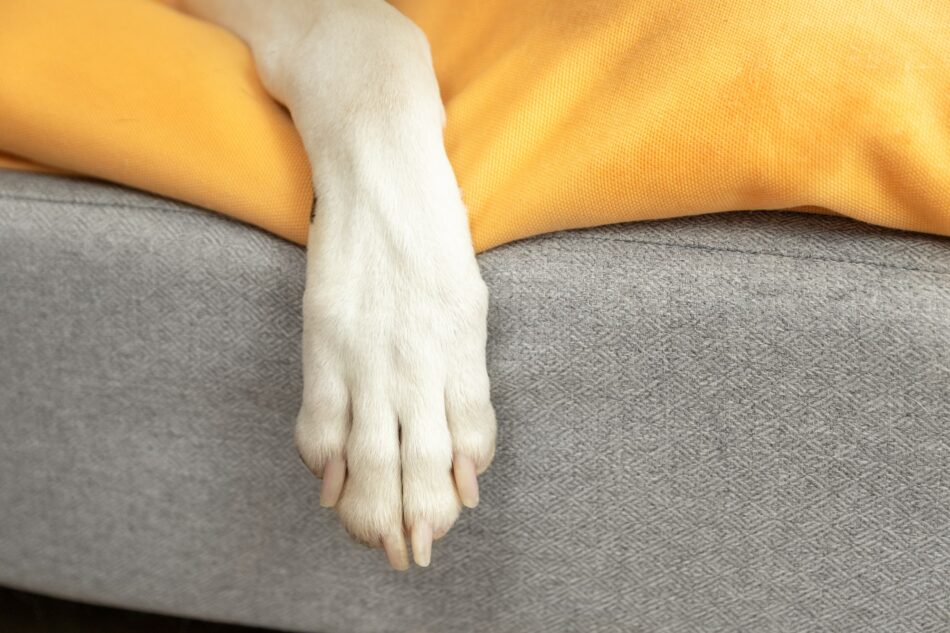
In the intricate tapestry of the animal kingdom, the paw stands as a remarkable adaptation and a testament to evolution’s creativity. From the stealthy cat’s paw to the unique polydactyl paws of the guinea pig, these appendages are diverse, functional, and revealing. But why do some animals have paws? In this guide, we journey through the history of the paw and unveil the fascinating insights that paws offer about the wonderful animals that bear them.
History of the paw
The story of the paw unfolds across millennia, tracing back to the evolutionary emergence of the first creatures to venture onto land from water. Limbs evolved into diverse forms to navigate various terrains, leading to the development of paws. These adaptive structures equipped animals with the ability to walk, climb, dig, swim, and manipulate objects, serving as the cornerstone for survival.
Before our pets were domesticated, they had to defend themselves to stay alive while hunting for their own food. While domestication has quieted many of those innate traits, still several haven’t changed, staying with the species throughout evolution. This includes the paw.
Dogs and cats are the main paw-ed animals that may come to mind. But before we had house cats and dogs, there were generations of wild cats and wolves roaming the Earth. In the wild, the main purpose of the paw was largely related to sound and shock absorption. The fatty tissue inside the pads helps animals jump and land without pain or noise which was especially helpful for silently hunting prey in the wild while also protecting limbs from impact.
The evolution of the paw is as fascinating as the evolution of mankind – every change significant for its new environment and needs. So if your best friend has four paws, it’s best to know them like the back of your hand.
What can the paw tell us?
Animal paws hold a great deal of information in letting us know and understand how our furry friends are feeling. For instance, did you know cats knead blankets and pillows when they’re feeling safe and content? And for some animals, they use their paws as a way to release sweat and cool down. Here’s a breakdown of some of the many details that we can learn from the paw.
Functionality over form
Paws, despite their differences in appearance, share a common purpose: functionality. Whether it’s the padded feet of a feline or the webbed toes of an otter, each paw is intricately designed to suit the lifestyle and habitat of the animal.
Insight into locomotion
The structure of paws reveals clues about an animal’s mode of locomotion. For instance, the cat paw is designed for pouncing, jumping, and clawing through nature. This is why having a sturdy cat scratching post for your feline friend is essential to support their natural instincts. Each animal possesses unique traits in their paws which lends themselves to their survival.
Environmental adaptations
Paws serve as a mirror reflecting an animal’s environment. For example, animals dwelling in snowy landscapes often sport larger, broader paws, providing better traction and acting as natural snowshoes. In contrast, animals in arid regions, such as the desert, might have padded paws to better endure hot surfaces.
Sensory significance
Paws are not merely appendages for movement; they’re sensory hubs of communication. The paw pads of animals are rich in nerve endings which gives them a heightened sense of touch. So as pet parents, it’s super important to be mindful of temperatures for your furry friend so you can accommodate them as needed. When the summer heat rises, be sure you have a memory foam dog cooling mat or ultra comfy cat cooling mat to help their sensitive paws get some relief.
Health clues
Observing an animal’s paws can also offer insights into its health. For example, if your dog’s paws have an unusual odor or the hair is overgrown between the paw pads, this could be an indicator of an ailment requiring veterinarian treatment. Likewise, bumblefoot, a common infection that can appear on guinea pig paws, is a sign that treatment is needed as well. Allergies remain the most common problem that dogs and cats have with their paws – noted especially by excessive licking or chewing at their feet. When was the last time you looked at your furry friend’s paws?
Omlet and your pets’ paws
The enigma of the paw extends beyond its physical presence; it embodies the evolutionary journey, environmental adaptation, and behavioral nuances of the diverse animals in our world. At Omlet we understand the significance of pets’ paws and create products to serve as a reminder of the marvels crafted by evolution. From cat scratching posts with lights and dog beds with customizable toppers, our products help captivate stories hidden within the very footsteps of our favorite furry friends.
This entry was posted in Cats
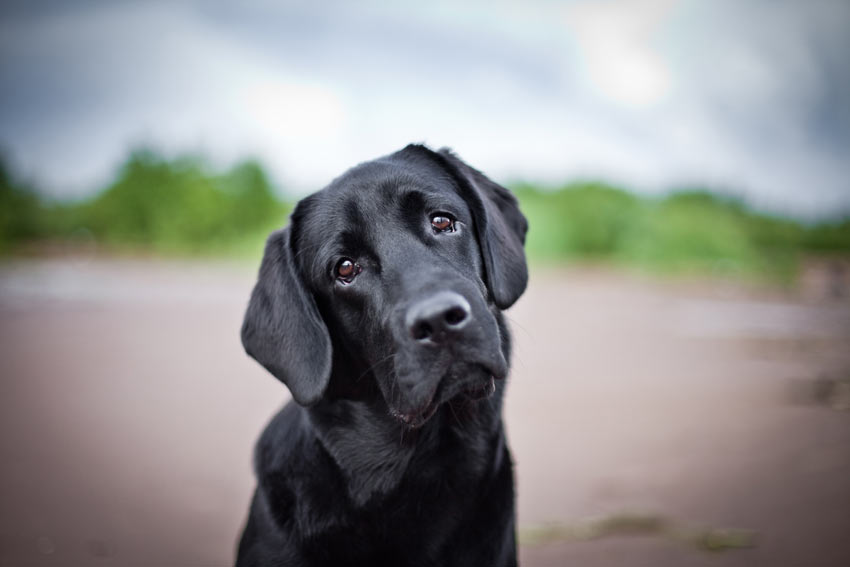
There is something very arrogant in assuming that only humans can experience deep emotions. We’ve all seen our pets excited and happy, and we also come to recognise when they’re sad. In other words, they experience feelings.
Sorrow in an animal is different from fear or anxiety. The latter things are brought on by stress, resulting from poor environment, poor diet, scary neighbours, cruel owners, or countless other factors that can make animals feel exposed or in danger.
Heartbreak, as any person who has experienced it knows, is something very different. It results from bereavement, or other forms of fundamental loss. Scientists are often eager to point out that we can never prove an animal feels these emotions. But many owners have seen it for themselves and have no doubt at all.
What Makes Dogs Sad?
A pet may become distressed if a certain person or a longstanding companion of the same species is no longer around – but only if that person or pet was one that the animal had completely bonded with.
A family dog will have a relationship with all the human members of its family, but there will usually be one favorite – an Alpha male or Alpha Female, if you like. Although the dog may miss the others, it is on this favorite, its main owner, that its affections will be focused.
If such a person leaves the household, for whatever reason, the dog’s first reaction will be one of separation anxiety. It will pine and lose its interest in things such as food, games and walks. Loss of appetite can lead to liver problems in a relatively short time, so keep an eye on the situation and be ready to turn to a vet for help.
The dog may also whine and cry more than usual, and may start to lick and chew household items, or its own fur or paws. Many grieving dogs find it hard sleeping, and will sit and whine by a door, or may simply go into hiding.
A lot depends on the breed, and on the individual animal too. But many dogs can certainly be classed as heartbroken in these situations. The grieving will last for several weeks, even months.
Time will cure the heartache, but in the meantime you can help by making sure the pet continues to have walks in its favorite places. If the dog enjoys staying in kennels, a short break there is a possibility too. You could also consider employing a dog walker, to give your pet a change of routine. Don’t be afraid to be more generous than usual with the snacks, treats and toys, too.
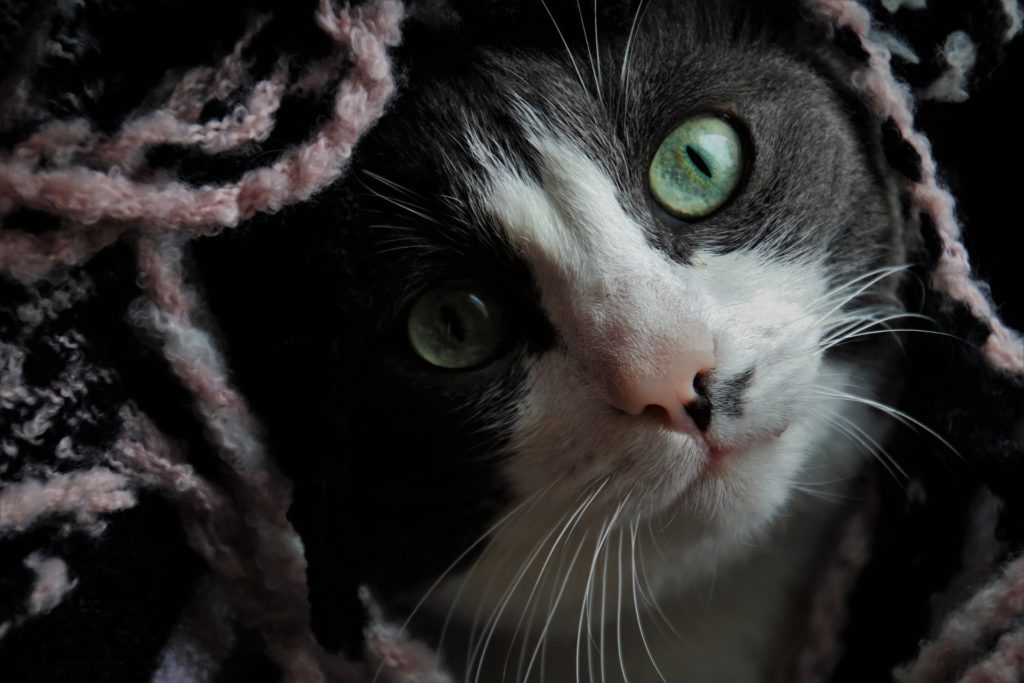 What Makes Cats Sad?
What Makes Cats Sad?
Cats can be harder to read than dogs. They will tend to lay low, hiding away more than usual. Some will become more vocal, mewing and crying for their lost friend. Many will lose their appetites, sleep less, and may even run away for days at a time.
Like dogs, a cat that stops eating can develop potentially fatal liver disease, so early intervention by a vet is recommended.
Many, however, soon transfer their main affections to another member of the household. Other, more independent cats seem to readjust without any problem.
What Makes Other Pets Sad?
Small mammals don’t appear to grieve when their owners disappear from their lives. But many will revert to a natural nervousness if they are no longer being handled and fed by their best friend. Someone else needs to step up and become the pet’s favourite.
Pet parrots who have bonded with a partner or owner are known to grieve the loss of a loved one, whether a fellow bird or a human. Loss of appetite and listlessness are the usual signs. Someone needs to keep up the contact and interaction, to ease these highly intelligent birds into their new lives.
The problem does not usually arise if the birds are kept in an open aviary setting. Smaller parrots such as budgies and lovebirds don’t seem to miss their human friends so intensely either, although they will certainly grieve if their feathered best friend disappears.
The Grieving Process
Above all, try to be upbeat and affectionate with the grieving animal. Pets pick up on our moods with an almost supernatural skill, so if we’re very sad, they may mirror our feelings. Again, this might be a good time to bring in friends or relatives more able to put on a happy face for the sake of the heartbroken pet.
Most pets will, with time, move on. Some older pets may never entirely recover. In all circumstances involving loss, all an owner can do is care for the animal as it readjusts to changed circumstances.
This entry was posted in Pets

According to folklore, birds choose their mates on St Valentine’s Day. A rare few only have to make that choice once, staying with the same partner for as long as both birds are alive.
There is something romantically appealing about this idea of birds sticking together for life. But not many species follow this lifestyle. The faithful few include many species of goose and swan, several of the owls and eagles, and some of the penguins. Many others are ‘serially monogamous’, meaning they stick with one partner throughout a single breeding season, but not for life. An estimated 90% of bird species fall into this category.
Mating for life is something much rarer. Parrots in captivity usually stick with one partner, as their choice of mates is limited. But the whole idea of bird fidelity is best captured in the image of two lovebirds cuddling up and rubbing beaks.
What’s the advantage in sticking together for life?
The chicks of birds of prey such as owls and eagles grow slowly. Rearing a big bird such as an osprey or golden eagle takes around three months from egg laying to independence. It helps save time if the parents start rearing their young early in the season, preferably in the same nest as last year. Lengthy courtship displays and nest-building are simply delays, and ones that can be avoided if two birds resume their old relationship each year.
The advantages of faithfulness may seem less obvious for smaller birds. But it ensures that both parent birds are focussed on the successful rearing of their chicks. The alternative is polygamy, in which the male strays away to mate with other birds, putting all the pressure on the hen bird to feed the chick. In a harsh season, having two parents working together can make the difference between life and death for the chicks.
Most mating-for-life species don’t actually live together outside the breeding season, though. Not in the wild, at least. But there is one famous exception – the Lovebird.
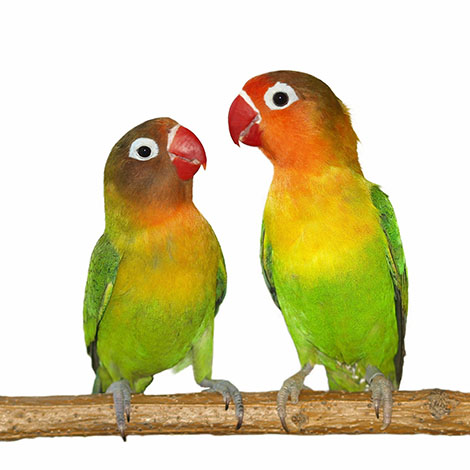 Lovebirds of a feather stick together
Lovebirds of a feather stick together
Lovebirds take mating-for-life very seriously. Most other ‘faithful’ birds rediscover their independence outside the breeding season, but Lovebirds live up to their name 24/7, 365 days a year.
Like most parrot species, in the wild all nine species of Lovebird live in flocks, and their social organisation is based on pairs. The strong bonds involved prevent bickering and fighting in the mating season. It’s a peace-keeping system that works so well, it’s surprising that other species haven’t followed a similar evolutionary path.
Lovebirds are bonded to the point of jealously. They may be our perfect picture of avian affection, but they will fend off any intruders. It is recommended to keep pairs separate from other birds, rather than including them in a mixed aviary – unless you have a huge space in which grumpy or jealous birds can easily find space away from each other.
A bereaved Lovebird, or one kept on its own, will become depressed. It will pine, stop eating, squawk, and become irritable. The exceptions are those birds that have been handled from a young age and have bonded with their human companion. Their affection is every bit as genuine with a human ‘partner’ as a feathered one.
There are downsides to this, though. A bonded lovebird will regurgitate food for you, and will need discouraging from attempting to mate!

Zebra Finches – Lovebirds of the Finch world
Most birds that live in flocks are monogamous – that is, they have just one mate each breeding season – but the Zebra finch takes it a step further. Many owners think the bird’s habit of mating for life is something that only happens in captivity, where choice of partner is restricted. But the little Zebra is every bit as faithful as the Lovebird, even in the wild.
In captivity problems can arise when birds die, or when new ones are added. A singleton in a group of Zebra finches will find it hard to find a mate without a fight. For this reason, ironically, it is actually best to keep these finches in pairs rather than big or odd-numbered flocks, as a single bird may be forced to become either a bully or a depressed outcast.
Love is in the air
Nature has found all sorts of ways of ensuring that the next generation of birds takes to the wing. At one end sit the cuckoos, taking no responsibility for parenting or relationships of any sort. Next come those birds that take the lots-of-mates approach. Most, however, opt for one partner per season.
But there’s something particularly appealing about those few species that mate for life. For Lovebird and Zebra finch owners, romance is an everyday fact of life.

This entry was posted in Pets











 Mipit’s a Jug like Lottie, who Henley chose for his rebellious nature, but despite wayward first appearances, he’s proven to be intelligent, loving and loyal. Within a few weeks, Mipit was doing things that Lottie had taken months to learn, and Henley decided to focus her assistance dog training with Mipit.
Mipit’s a Jug like Lottie, who Henley chose for his rebellious nature, but despite wayward first appearances, he’s proven to be intelligent, loving and loyal. Within a few weeks, Mipit was doing things that Lottie had taken months to learn, and Henley decided to focus her assistance dog training with Mipit.
























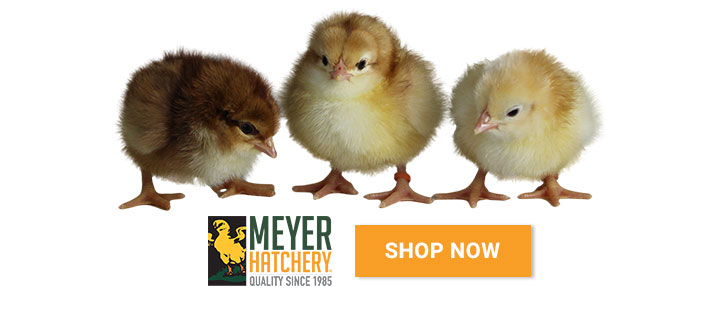














 With World Hamster Day upon us on April 12th, what better time to celebrate these furry favorites? There are many reasons why so many people decide to get a hamster. Here are 10 of them:
With World Hamster Day upon us on April 12th, what better time to celebrate these furry favorites? There are many reasons why so many people decide to get a hamster. Here are 10 of them:




 Photo by
Photo by 

 Photo by
Photo by 


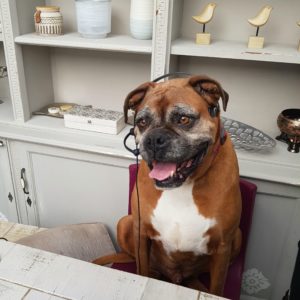
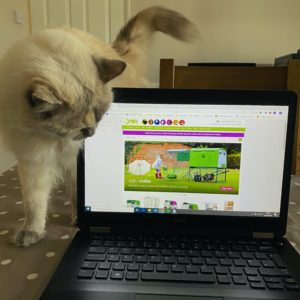











 What Makes Cats Sad?
What Makes Cats Sad?
 Lovebirds of a feather stick together
Lovebirds of a feather stick together
